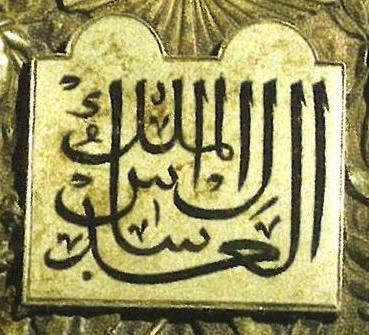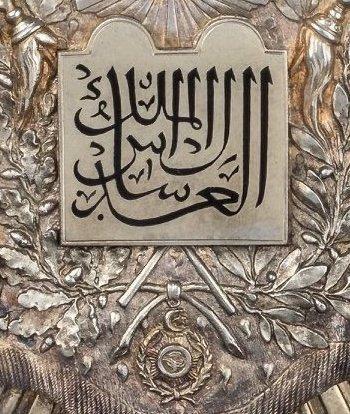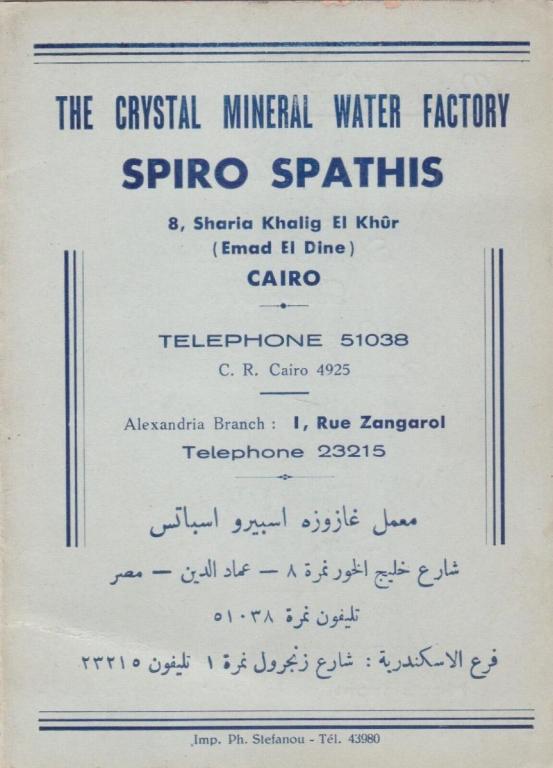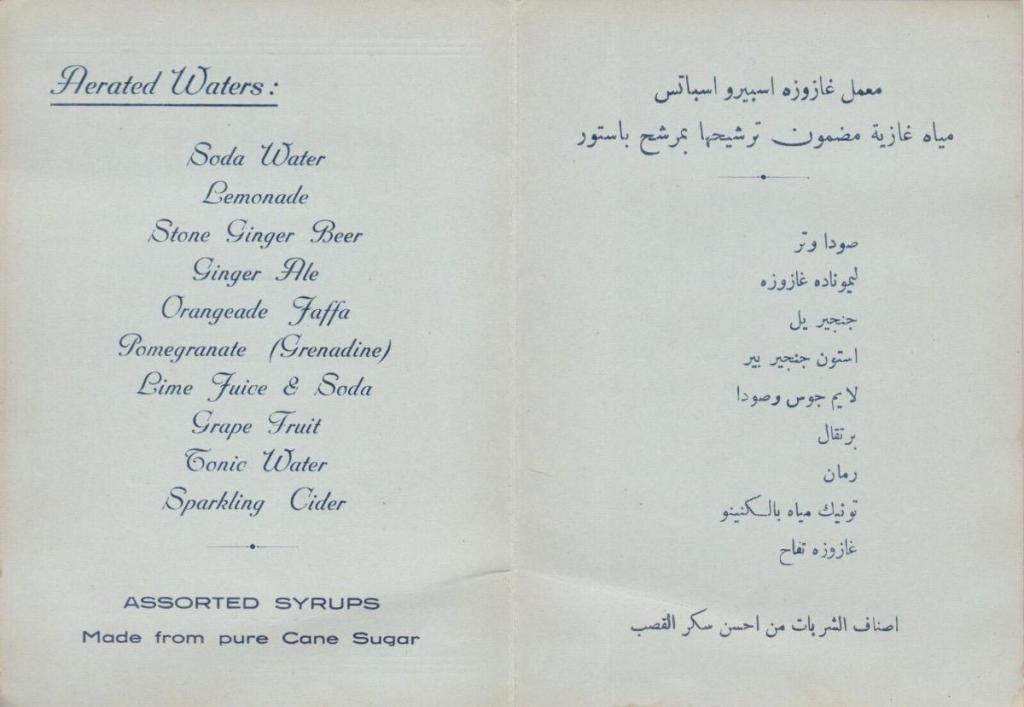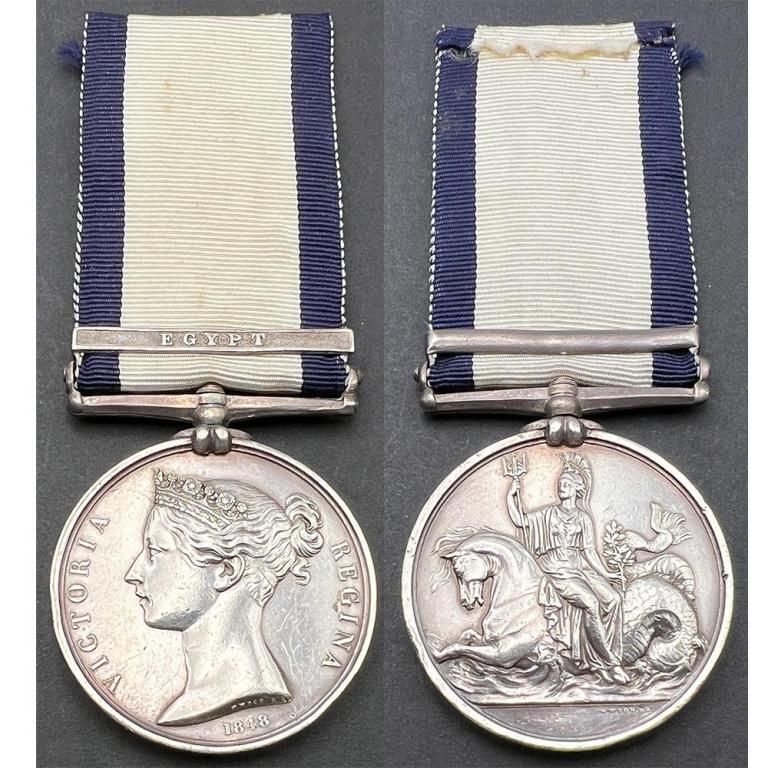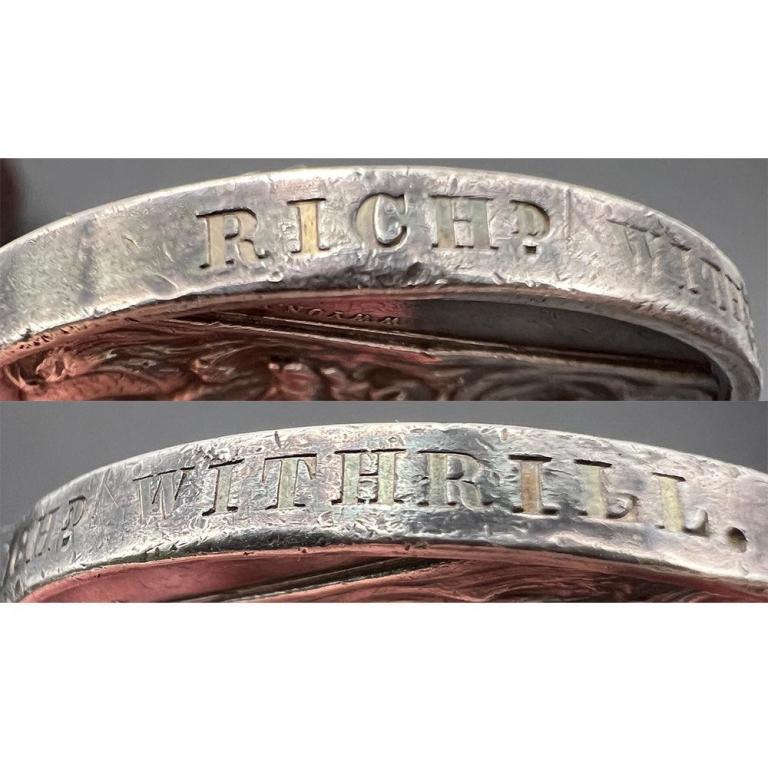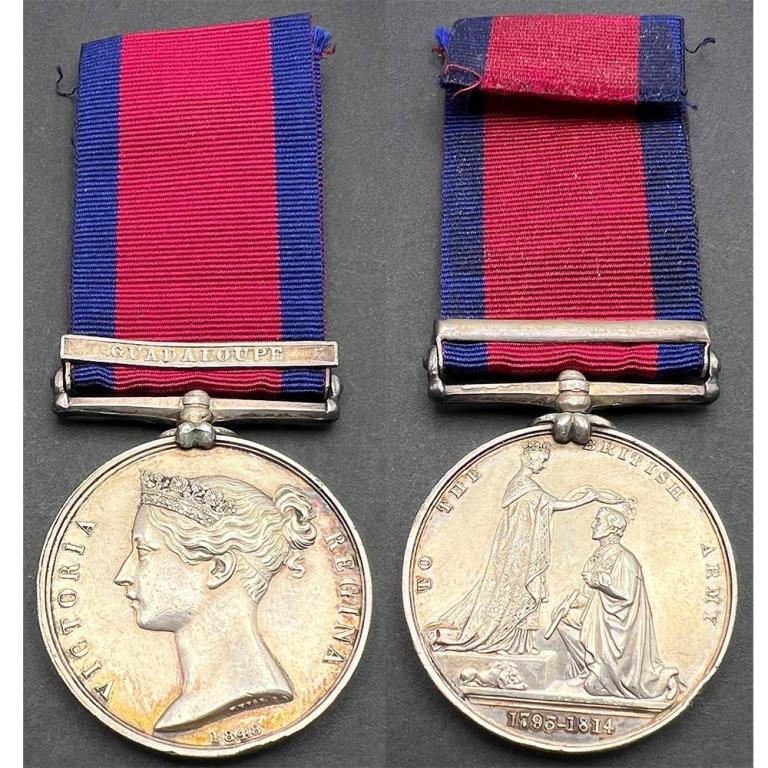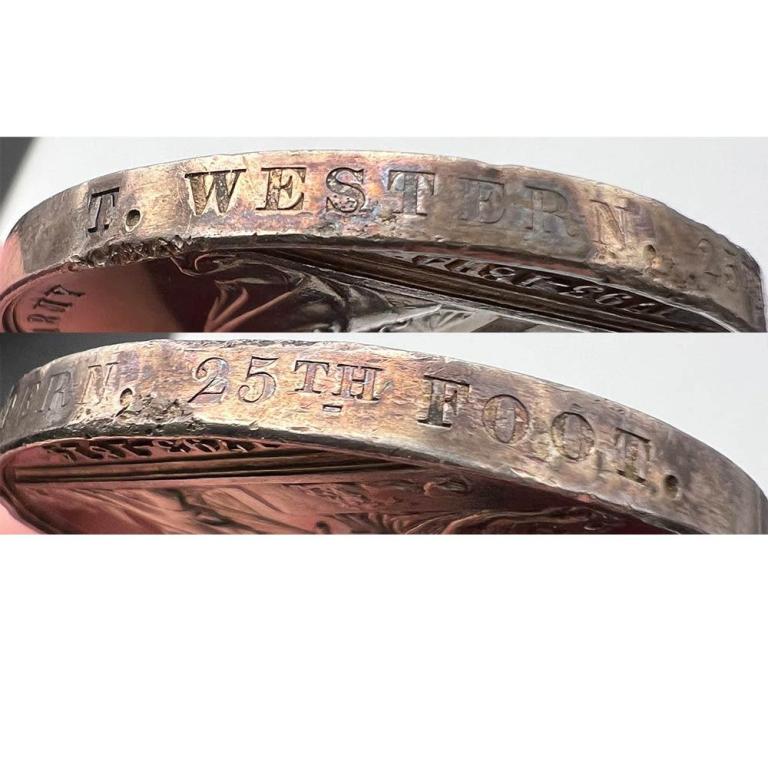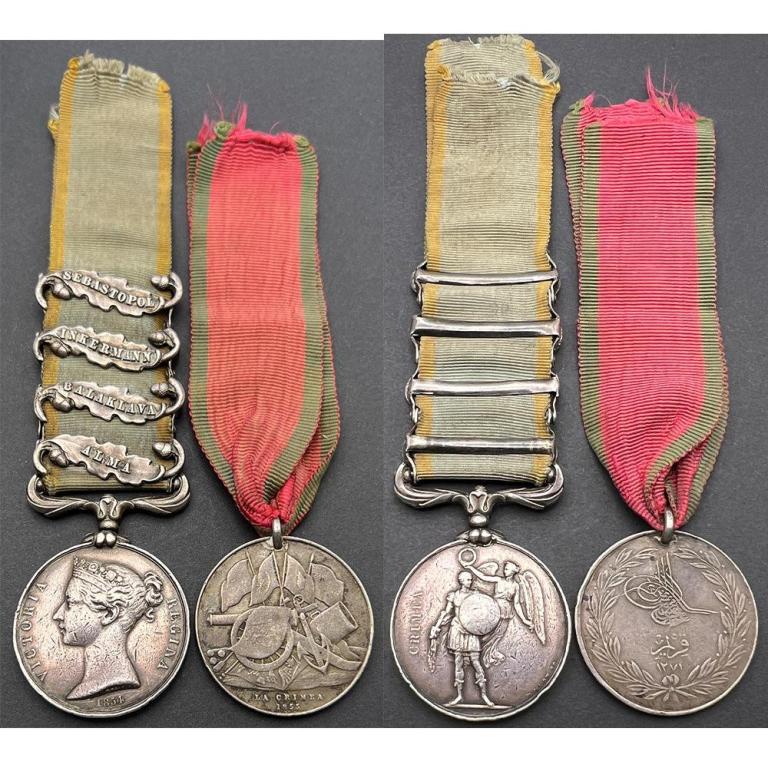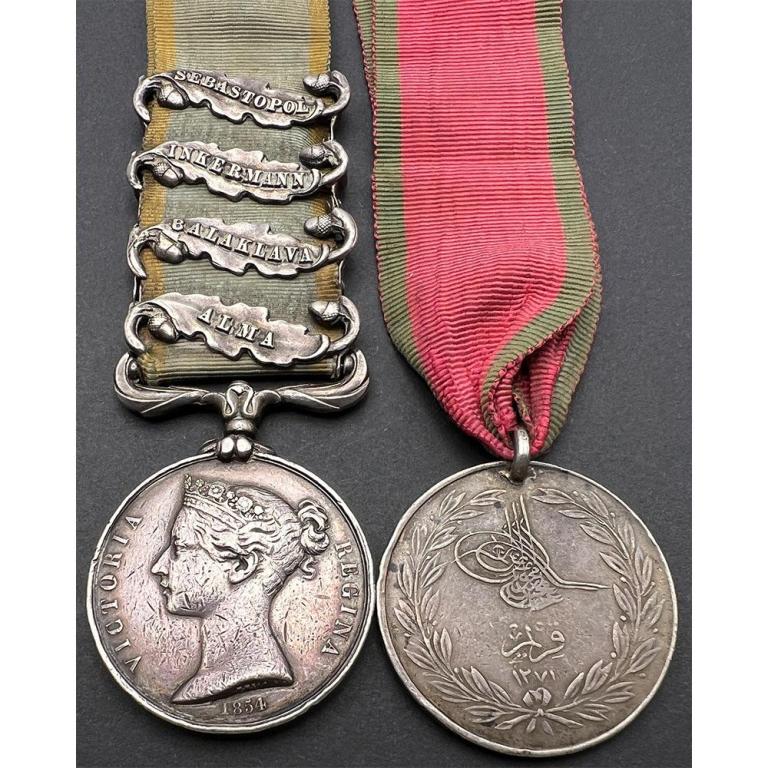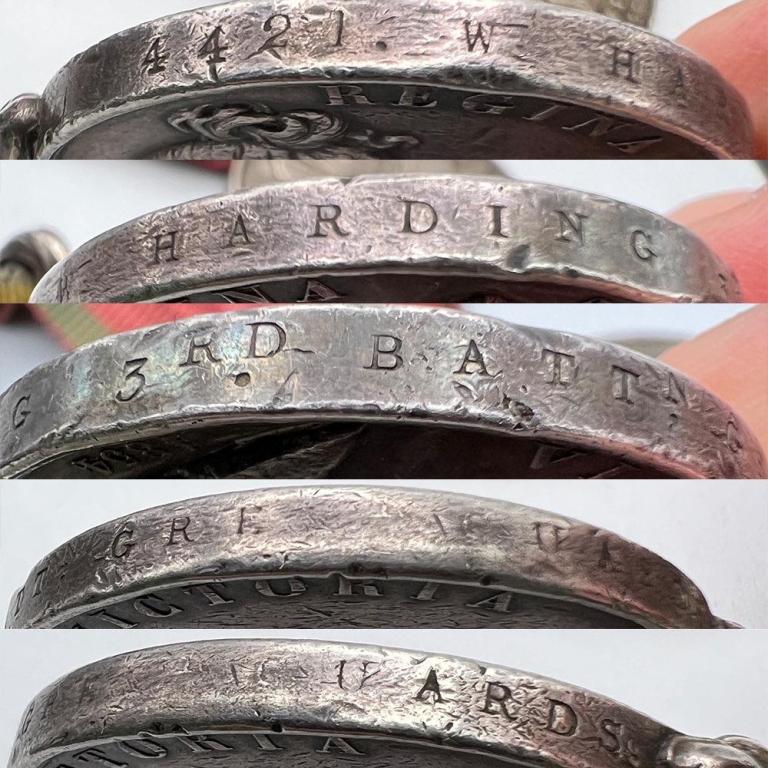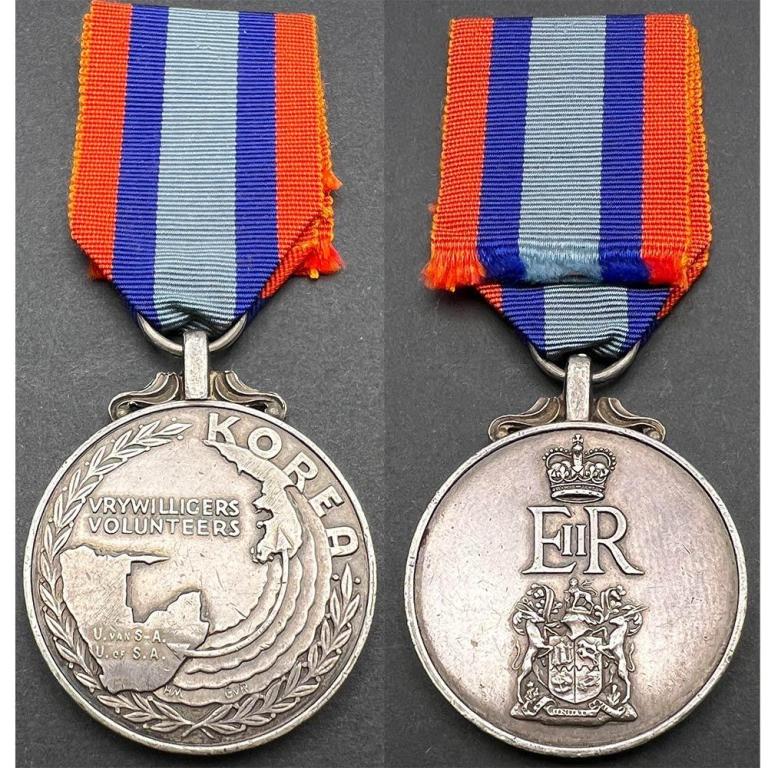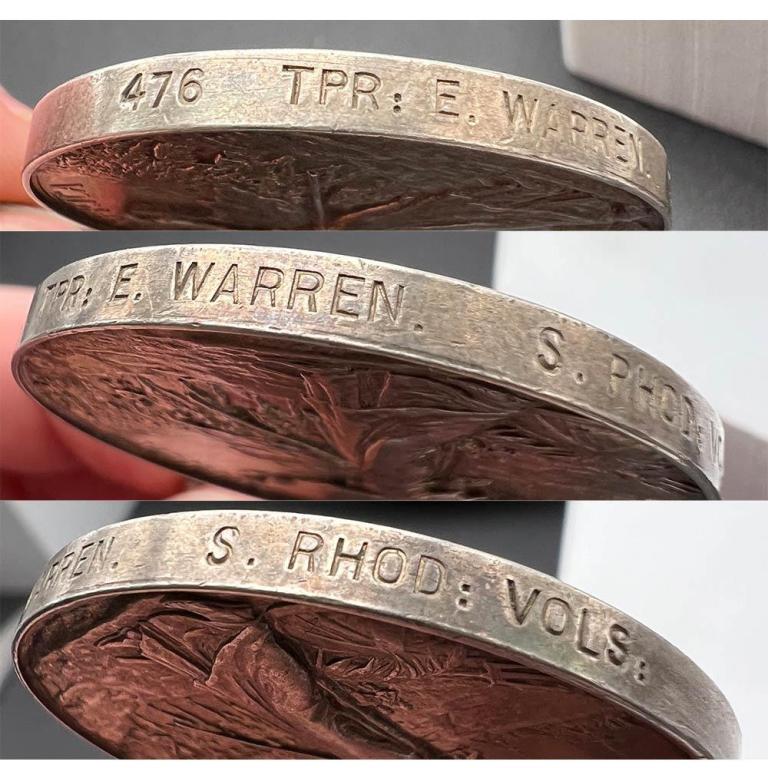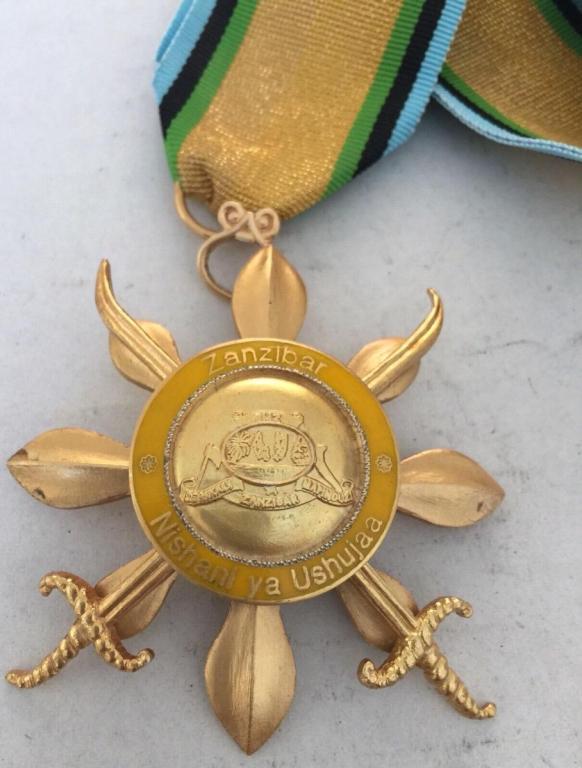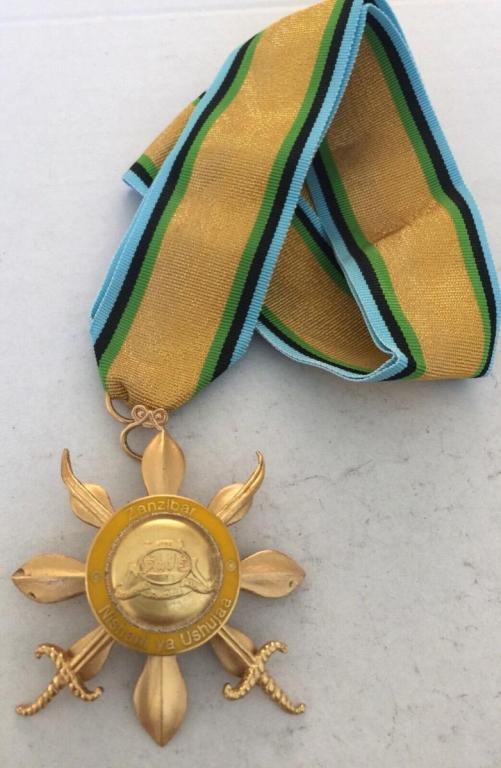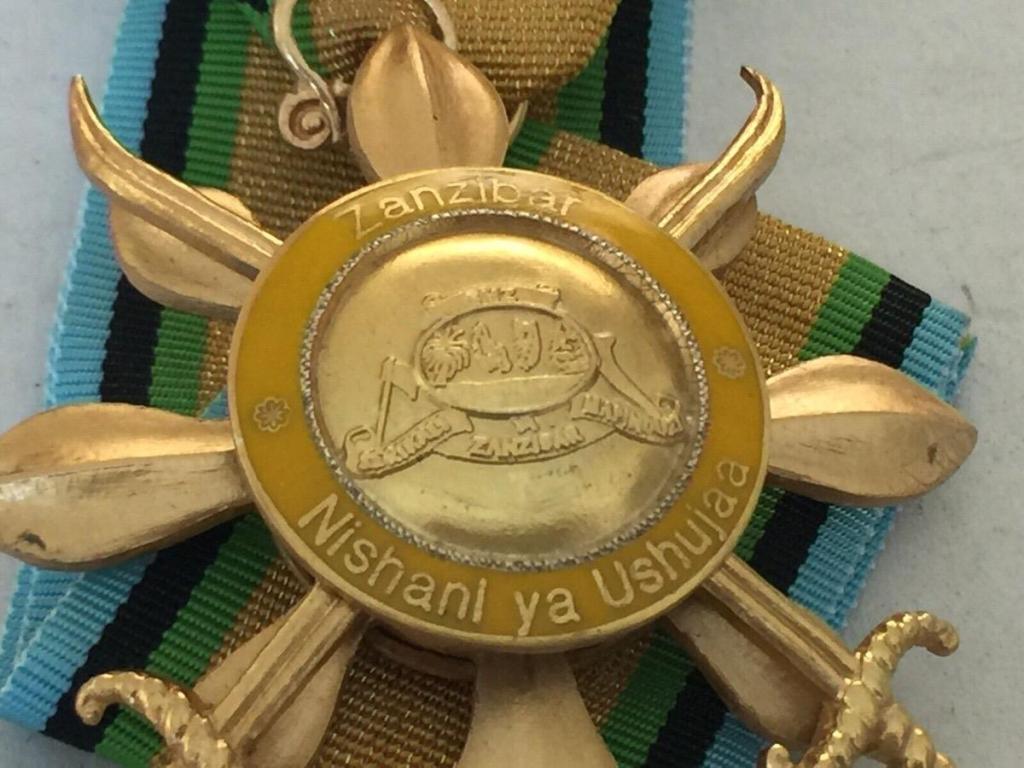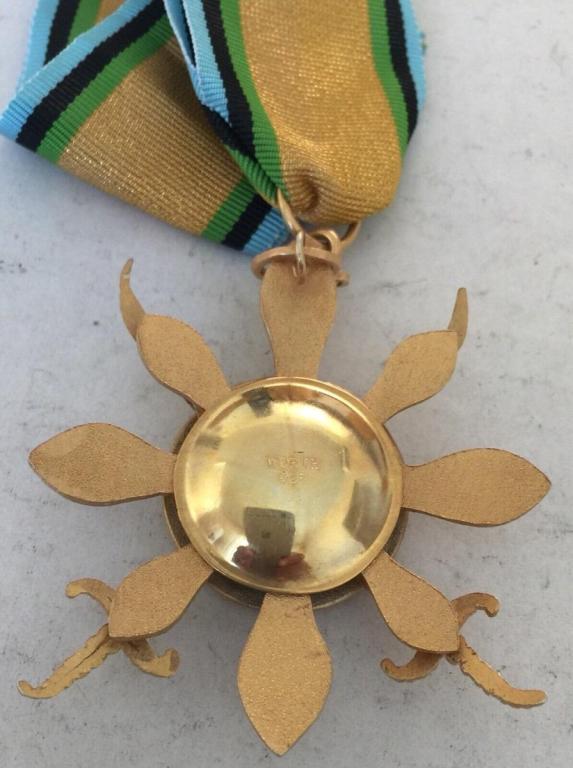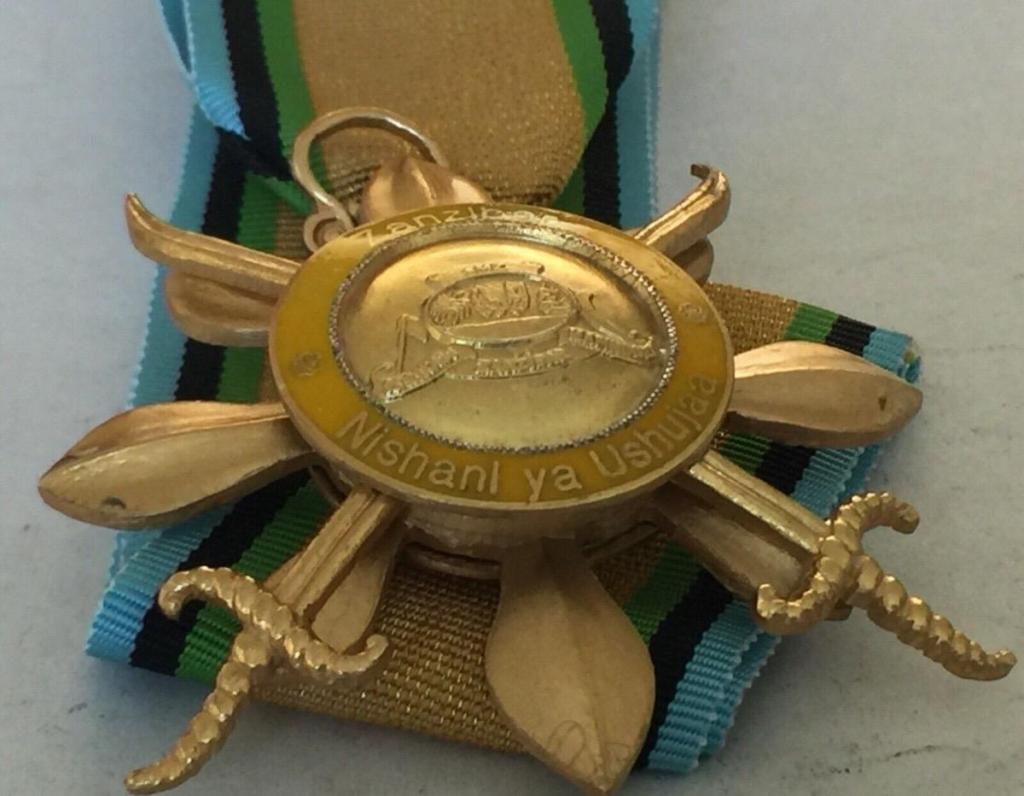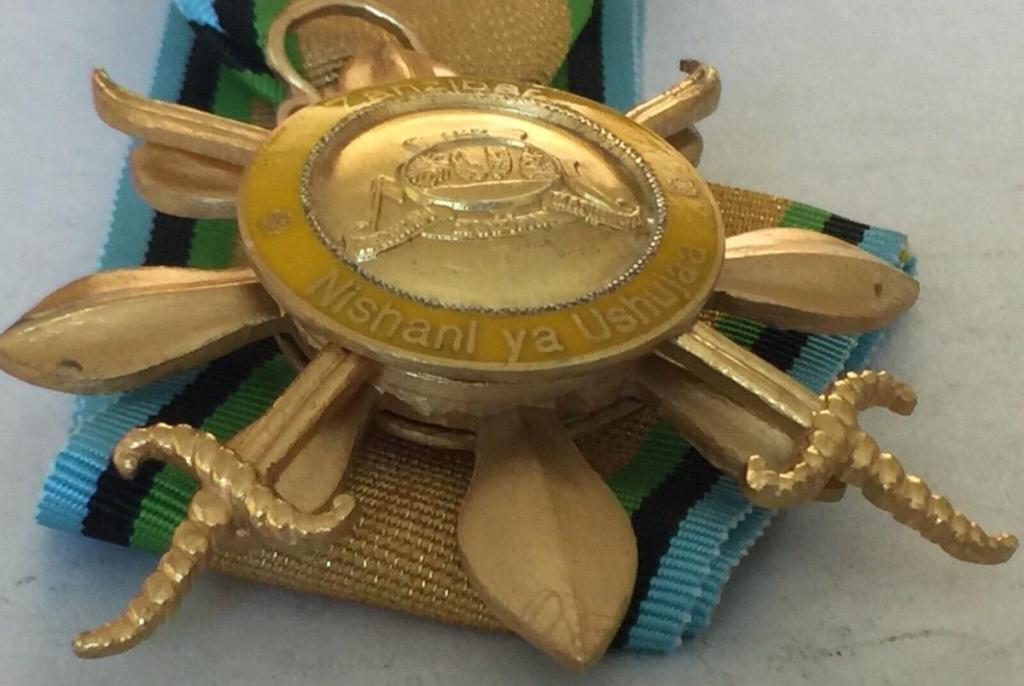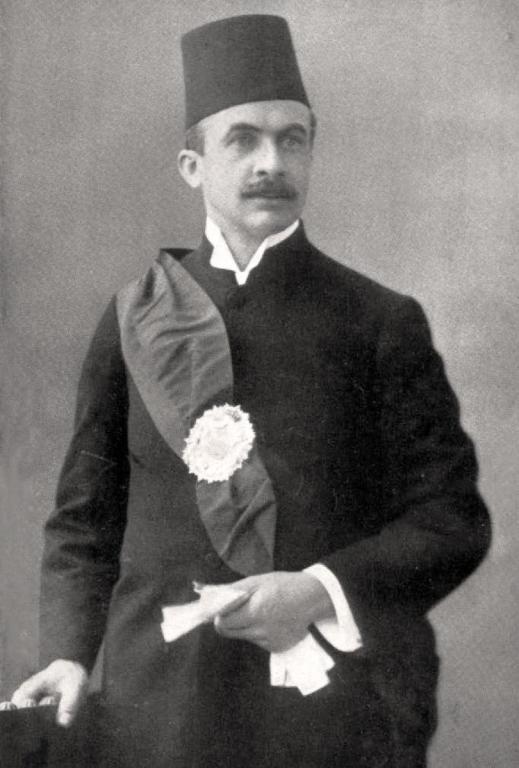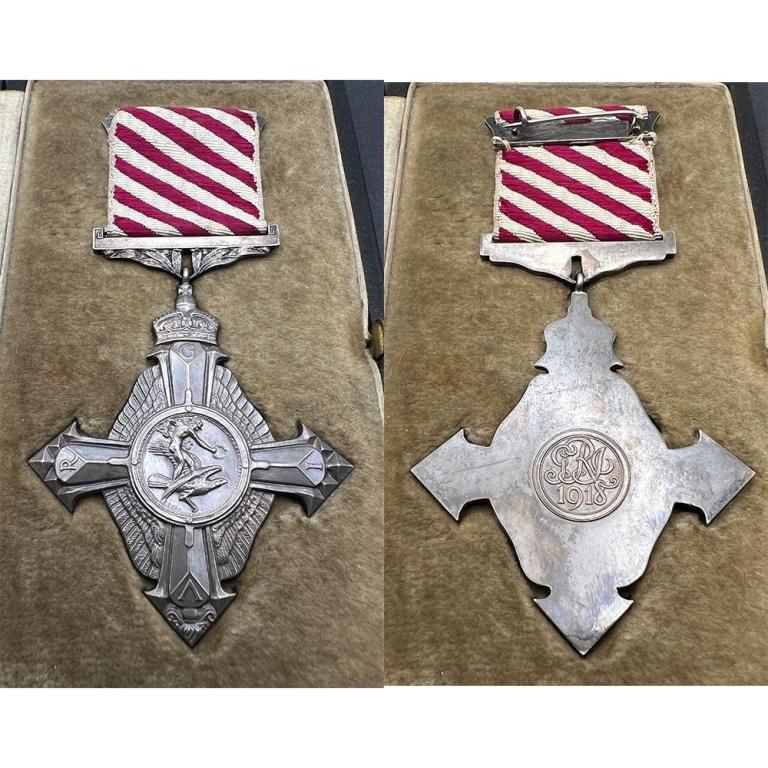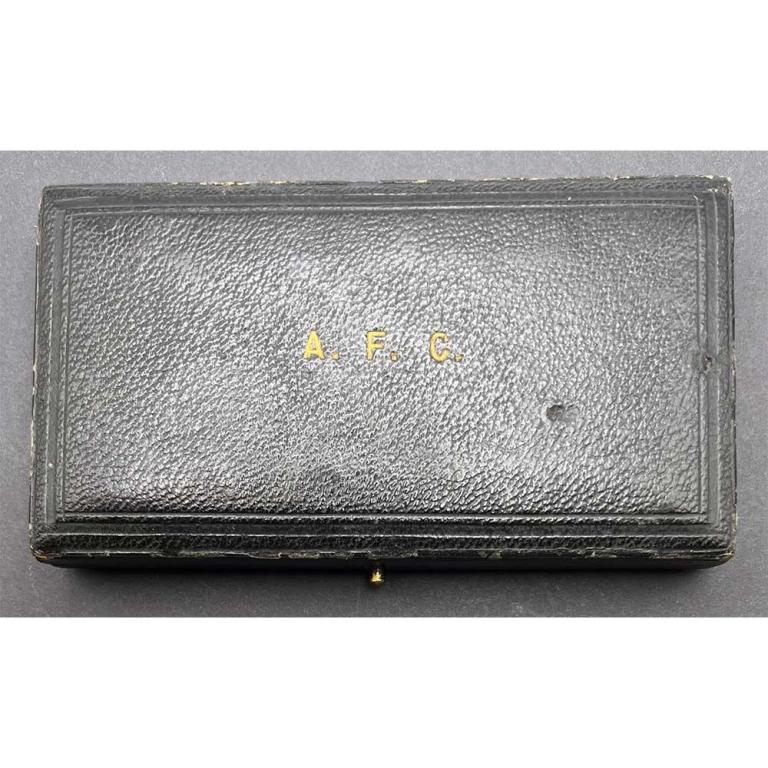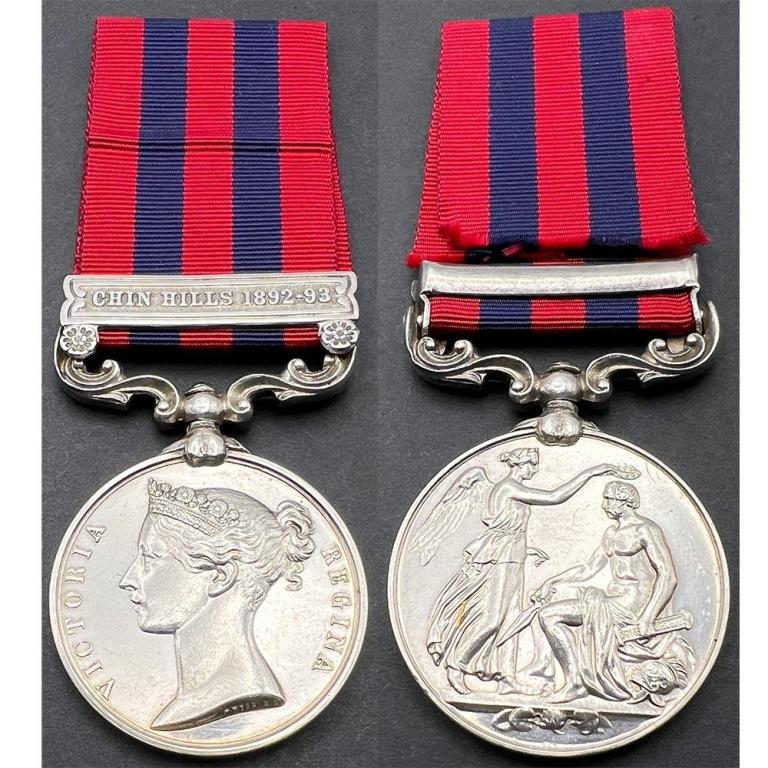-
Posts
2,429 -
Joined
-
Last visited
-
Days Won
5
Content Type
Profiles
Forums
Blogs
Gallery
Events
Store
Everything posted by Rusty Greaves
-

Egypt Khedivate Judge's Badge question
Rusty Greaves replied to Rusty Greaves's topic in Middle East & Arab States
Above is a low-resolution image of silver and gold District Courts badge from a 23 October, 2022 post on an Arabic language Facebook page called "Heart Eyes" ("عيون القلب"): https://www.facebook.com/photo?fbid=633430158475027&set=a.633430128475030. The same images also was uploaded to this Facebook page on 18 December, 2016 (https://www.facebook.com/photo/?fbid=784999381641169&set=pb.100054241460188.-2207520000). There is no information associated with this image. The cropping on Facebook cut off some of the inferior embellishment and the crescent and star on the superior portion of the crown and some of the superior embellishment. The calligraphy is most similar to what I have called Froment-Meurice Group 2 (see the 5th-9th photos in my post of 6 September, 2021 on this thread). -

Egypt Khedivate Judge's Badge question
Rusty Greaves replied to Rusty Greaves's topic in Middle East & Arab States
I came across images of a gold Appeals Court badge made by Wolf Horovitz on a Russian auction site, Znak https://www.znak-auction.ru/limg2.htm?c=d94820&n=1). The first four images below come from the 14 February, 2014 auction (25) by Znak, Lot 47. High-resolution image of the obverse of this Horovitz-made Appeals Court badge. The description identifies the maker as Horovitz, an image of the reverse shows the maker's mark, and an image of the badge in its case shows the W. Horvitz name on the inside of the upper lid. The description has some odd information about the assay hallmarks on the reverse, but gives the material correctly as gilt silver (vermeil), the size as 115 high x 86 mm, and weight as 189.50 g. The calligraphy of the central tablet does not match that seen on most other badge identified as being made by Horovitz (see the 14th-17th photos in my post of 6 September, 2022 on this thread). The calligraphy closely matches that seen on the Mahmoud Saïd badge (shown as the 23rd photo in my post of 6 September, 2022), possibly helping to identify his badge as potentially being made by Wolf Horovitz. Compare the calligraphy to the 5th photo below that is the central table of the Mahmoud Saïd badge. Horovitz-made badges seem to show the greatest amount of variability among the few internet images I have found, compared with other makers of these badges. It is unclear in the above photo whether the oak and laurel branches are gilt (see the 3rd photo below in this post where those branches appear to be silver). When enlarged, it is visible that the tugra in the Order of Medjidie element is upside down, as seen on all other Horovitz and Rudolf Stobbe Mixed Courts badges. Moderately-high resolution image of the reverse of this Wolf Horovitz Appeals Court badge. The name "HOROVITZ" is clearly stamped above the 2 rivets. The 3 Egyptian silver hallmarks are struck upside down compared with the correct orientation of the badge. They show a mark for 900 silver (I can't tell if the first mark indicates the Cairo or Alexandria assay office), the cat mask for Egyptian-made silver, and what appears to be a date hallmark of "M"=1937-1938. I don't know if the Arabic characters suggest this badge may have belonged to an Egyptian judge of the Appeals Court. The Znak description claims that this Mixed Courts badge belonged to M. Puech, along with another medal in the auction, Lot 47 that is one of the French commemorative Justice Medals, using an obverse design by A. Borrel and a wreath on the reverse designed by H. Dubois. The obverse design has been used for a variety of justice medals since ~ the mid 19th century to at least the early 21st century. Lot 47 is inscribed on the reverse with "TRIBUNAL DE LA SEINE, M. PUECH · VICE PRÉSIDENT". There is no date on that commemorative medal (some issues do have dates, usually on the reverse). I have not found a second example of the M. Puech medal. I have not found an online biography of M. Puech. Wikipedia (https://en.wikipedia.org/wiki/Louis_Puech) identifies Louis Puech (1851-1947) as a lawyer who held government positions and was a conseiller municipal for Paris 1893-1898 and a député for the Seine from 1989-1932. André Puech (1885-1960) was an avocat á la Cour of the 3e arrondissement de Paris from 1921-1944. No M. Puech is listed in the the 50th anniversary volume about the Mixed Courts (Les Juridictions Mixtes d'Égypte 1876-1926 Livre d'or Édité sous le Patronage du Conseil de l’Ordre des Avocats á l’Occasion du Cinquantenaire des Tribunaux de la Réforme). That only means he had not served on the Appeals Court prior to January-February 1926 when that anniversary volume was published. I do not find his name in other publications postdating 1926 and that were written after the closing of the Mixed Courts on 14 October, 1949. I cannot evaluate whether M. Puech may have been a member of the Mixed Courts and would have been the owner of this badge. The "M" on the reverse of the judical commemorative medal may stand for Monsieur rather than a first name. Another Wikipedia article (https://fr.wikipedia.org/wiki/Liste_des_conseillers_généraux_de_la_Seine) identifies Louis Puech as the Président du Conseil général de la Seine (1918-1919) and Président du Conseil municipal de Paris (1922-1923 & 1940). It also provides slightly different dates for his birth and death (1859-1945, and gives his initial appointment as 1908). The appointment dates for Louis Puech to other positions seem to preclude any potential role on the Egyptian Mixed Courts. Puech (André or Louis) might have owned this badge as a collector's item, but he probably was not a judge on the Mixed Tribunals. High-resolution photo of this same Appeals Court badge resting in the medal bed of its case. In this image, the oak and laurel branches appear to be silver with no vermeil. The inscription on the inside of the upper lid identifies the address of Wolf Horovitz's shop: "W. Horovitz, 26 Rue Chérif Pasha, Alexandrie". The case is in very good condition. High-resolution image of the closed case showing the outside of the upper lid. Above is the cropped image of the central tablet of the badge belonging to the Mahmoud Saïd badge (shown as the 23rd phot in my post of 6 September, 2022). The original image came from from the appendix to an art volume publication on Mahmoud Saïd’s paintings (Didier Hess, Valérie & Hussam Rashwan (eds.), 2016. Mahmoud Saïd: Catalogue Raisonné Volume 2. Drawings. Skira Editore, S.p.A., Milano. [distributed in the USA, Canada, & South America by Rizzoli International Publications, Inc. New York; distributed elsewhere by Thames & Hudson Ltd. London]. Plate A 177, pg. 865 [incorrectly identified as a “Medal of Justice”]. ©2016 Valérie Didier Hess; ©2016 Dr. Hussam Rashwan; ©2016 Mahmoud Saïd Estate; ©2016 Skira editore). The calligraphy is similar, but not identical, to that on the District Court badge made by Horovitz that I illustrated as the 1st photo in my post of 27 May, 2022 and in the 1st-3rd photos and the 5th photo (cropped view of the central tablet and the upside down tugra in my post of 17 June, 2022 on this thread that came from the Facebook page of Hamdy Charmy Photography (https://www.facebook.com/H.Charmyphotography/photos/pb.100063747398706.-2207520000../1694086190745364/?type=3). As noted, this may suggest that the Mahmoud Saïd badge may have been made by Horovitz, reducing the number of unidentified makers of these badges to 4. Cropped image of the calligraphy on the central tablet and the incorrectly oriented tugra in the Order of Medjidie design element of Hamdy Charmy's Horovitz-made District Courts badge. This is the 5th photo from my post of 17 June, 2022 on this thread. The Hamdy Charmy badge is shown in a case similar to the Znak example with Horovitz's same and address on the interior of the upper lid. The calligraphy on the Znak example also is similar to that on the Horovitz District Court badge illustrated as the first image in my post of 10 August, 2024 on this thread. That photo, shown above, is from an Arabic language Facebook site, titled the "Egypt Historical Guide" (https://www.facebook.com/photo/?fbid=658578132962867&set=a.702389416471411.1073742467.233719140005110). The original photo is of low-quality, so it is not simple to compare with the Znak badge. -

King Fuad I medal for soda pop production?
Rusty Greaves replied to Rusty Greaves's topic in Middle East & Arab States
I have no idea what kind of recognition Spiro Spathis actually may have gotten from King Farouk I. Oddly, I just came across an undated advertising card for this business from a current eBay auction (https://www.ebay.com/itm/276699876832?itmmeta=01JAZWRD1ASR1KMA7WR0N67MGH&hash=item406c990de0:g:5FsAAOSw~xJnGhSk). As noted in my post here of 7 September, the company opened in 1920 with just lemonade flavor. Apple cider was added in 1921, tonic water was added in 1925, and in 1935 additional flavors were added (at least grapefruit, grenadine, lime juice & soda, maybe others as well: https://spirospathis.com/wp-content/uploads/2024/06/SpiroCompanyProfile.pdf). Whatever recognition the business got from the king is dated to 1941. -

US Dept of State Special Agent's Badge 1917
Rusty Greaves replied to Rusty Greaves's topic in United States of America
It seems unlikely that another original 1916 or 1917-design U.S. Department of State Special Agents' Division badge is going to surface soon. Today I have some examples of Department of Security Services (DSS) challenge coins and pins that employ adaptations of the original badge design in their execution. One DSS agent told me there was a popularity spate of popularity in using the original badge design for different Regional Security Offices' (RSO) challenge coins. The selection of challenge coins I have found and illustrated below appear to date mostly to the period between approximately 1996-2018. A few of the items shown below are anniversary issue coins and pins (80th, >90 years, and the centennial celebration in 2016). All of these items were recently offered on eBay (except the Mumbai RSO Challenge Coin coin shown in the last 2 images from a 2021 auction). Most of the photographs below can be zoomed for additional details. eBay image of a DSS lapel pin. My slightly oblique photo of this pin for additional details of the original badge element design. Above are 2 photos of a DSS lapel pin using the form of the original 1916 special Agents’ Division badge. This version includes the name of the Diplomatic Security Service on the superior banner legend and “SINCE 1916” below the eagle and above the “US” on the lower half of the pin. The dates of the formation of the Special Agents’ Division,1916, and 1996, presumably when this pin was made, appear on either side of the eagle. The 1996 date shows this was made during the 80th anniversary year for the DSS (also see the reverse of the next challenge coin and the 80th anniversary pin below). The pin measures 28 mm in height and 19 mm in maximum width. It appears to be made of an unspecified white metal that is chrome plated. No information on the material is provided in the description. The first image above comes from a recent eBay offering of this pin, arrived on the picklock website (https://picclick.com/US-Department-of-State-Diplomatic-Security-Service-Special-263644483132.html). The second image is one I took, and shows some details not visible in the eBay photo. The reverse of the pin reads: “VWE 717-299-6774”. The VWE 10 digit number is a common mark on pins for many federal agencies. Obverse Reverse Above are 2 illustrations of a DSS Challenge Coin using a similar form of the original design as shown above on the lapel pin. I believe that the original Special Agents' Division badge design represents the reverse of this challenge coin. The upper banner on the original badge element of the design is labelled Diplomatic Security Service and it has the same “SINCE 1916” motto as the pin, but employs a slightly different form of the original badge design. As with the pin shown in the first 2 images of this post, the dates 1916 and 1996 appear on either side of the eagle, indicating this was made during the 80th anniversary year for the DSS (also see the 80th anniversary pin below), although it is not specifically an anniversary coin. The obverse shows a form of the recent Special Agent badge (most similar to the 1987-1989 version) and this element may be gilt. This coin measures 44 mm in diameter. It is made of an unspecified white metal, probably enamel paint, and both faces are encased in Lucite. The form of this badge is nearly identical to one issued after 2006 to commemorate DSS as "A GLOBAL FORCE FOR OVER 90 YEARS" (see below). Obverse Reverse DSS Challenge “Coin” in the form of the original badge outline, for the U.S. Mission to New Zealand. This item also identifies the Diplomatic Security Service on the upper banner and repeats the “SINCE 1916” motto in the same placement as the above pin and challenge coin. The “coin” measures 57 mm tall x a maximum width of 42 mm. It is made from an unspecified white metal and enamel paint, the metal surface presents a brushed appearance. I personally find this a rather cartoonish example of the form of the original badge used as the obverse of this challenge “coin”. A very similar design adaptation of the original badge is shown in the second-to-last image in this post for a DSS Challenge Coin for the Regional Security Office in Mumbai, India. Obverse Reverse DSS Challenge Coin issued for the U.S. Embassy in Ottawa Canada. The obverse exhibits a version of the original 1916 badge with the upper banner motto reading “SPECIAL AGENTS DIVISION”. All of these coins that include this badge motto spell “AGENTS” without the possessive used on the original badge (”AGENTS’). This challenge coin measure 49 mm in diameter and is made of an unspecified white metal and enamel paint. Obverse Reverse DSS Challenge Coin for the Los Angeles Field Office. The obverse identifies this as an issue during the centennial year of 2016. The original badge design on the obverse of this coin also uses the “SPECIAL AGENTS DIVISION” motto on the upper banner. As with each of these challenge coins, several design components of the 1916 badge are unique to this coin. This is one of the best executed adaptations of the original badge design on these different challenge coins. The reverse also carries a small representation of the original 1916 badge in the lower right of the Baker, CA to Las Vegas, NV map element. That small badge also has the "“SPECIAL AGENTS DIVISION” inscription on the upper banner and no other dates on the badge element. This challenge coin measure 57 mm in diameter and may be made of a bronze (given the weight and the color of the edge and some of the lettering), possibly also an unspecified white metal or chrome plating, and enamel paint. My photo of this 80th anniversary pin. Image from the eBay offering of this badge (from: https://www.ebay.com/itm/156099814020?mkevt=1&mkcid=1&mkrid=711-53200-19255-0&campid=5338722076&customid=&toolid=10050). Above is an 80th anniversary DSS lapel pin from 1996. This pin has the same dimensions as the first example shown in this post, measuring 28 mm in height and 19 mm in maximum width. It is made of an unspecified white metal and probably has a chrome plating, in addition to the blue enamel paint. The upper banner has the DSS name and the dates 1916 and 1996 are placed on either side of the eagle. “80 YEARS” is marked below the eagle instead of the motto “SINCE 1916” on the other pin shown in the first 2 images of this post and on several of the original badge designs on these challenge coins. I illustrated a 75th anniversary DSS coffee mug that also use the original badge design as its log in my post on this thread of 1 May, 2023. The reverse of the pin also reads: “VWE 717-299-6774”, the same as the first pin illustrated on this post. Obverse Reverse The above DSS Challenge Coin is almost identical in design to the first challenge coin shown in the is post (3rd-4th photos). The obverse is identical to that challenge coin, with a recent Special Agent badge element (most closely resembling the 1987-1989 form, but probably just an adaption of the badge in use post 2006). The weight and size (44 mm diameter) of this coin are identical to the example shown in the 3rd-4th photos here. The coin also is encased in Lucite. The reverse shows the same version of the original 1916 badge design as on the first coin illustrated here and has the same superior motto on the reverse: “A GLOBAL FORCE”. The size and spacing of the 3 stars are slightly different to accommodate the different lower inscription. The 1916 badge design on the reverse is marked with the name of DSS, “SINCE 1916), and has the dates 1916 and 1996 on either side of the eagle. The scrollwork in the middle margins of the coin do not have the incursion of blue enamel paint into some portions as seen on the first coin illustrated on this thread and shows the detail of the scrollwork better than that other coin in the 3rd-4th photos here. This coin would have been minted sometime after 2006. This is a “kind of anniversary” coin with the lower legend on the reverse reading: “FOR OVER 90 YEARS”. Did DSS forget to order a 90th anniversary coin/pin in 2006? Obverse Reverse DSS Challenge Coin for the Regional Security Office in Kabul, Afghanistan. The original 1916 badge element on the obverse is the most detailed version of this design on these coins. The upper banner reads: “SPECIAL AGENTS DIVISION”. There are rays around the eagle, as on the original badge, and the execution of the scrollwork is much more detailed than on other coins and the 2 pins shown here. This coin measures 50 mm in diameter. I feel this is the best adaptation of the original badge design on any of these challenge coins. This is probably the obverse, but I am uncertain. Probable reverse Above is a DSS centennial “Challenge Coin” in the form of a bottle opener. I am not certain which face is the obverse, but am presenting it as though the face with the modern DSS Spacial Agent badge (possibly based on the 1989-2021 form, without the “US” under the eagle as the opening for inserting [beer] bottles) is the obverse. The reverse has the form of the 1916 badge labelled “SPECIAL AGENTS DIVISION” and is the second-most detailed execution of this design element (after the Kabul RSO coin shown above). The badge-form opener measures 76 mm from the most inferior point to the highest portion of the wings, and 72 mm to the central shoulders of the eagle. The maximum width of the badge is 57 mm. I do not know what this opener is made from. DSS pin apparently made for the centennial year of 2016. The original badge element is marked with the DSS name and the motto: “SINCE 1916” below the eagle. There are no bracketing dates of 1916 and 2016 on either side of the eagle, instead those dates are placed on the black background to each side of the badge element. The scrollwork is similar to the other 2 silver-colored pins shown above. However, the badge element and all the lettering has a gold cast. The obverse is coated in Lucite. The reverse is unmarked and shows the pin is made of an unspecified white metal. This pin measure 28 mm wide x 19 mm tall. My photo of this 2016 DSS UNGA pin Above is a photo of the same pin from the recent eBay offering (https://www.ebay.com/itm/165036454555?_trkparms=amclksrc%3DITM%26aid%3D1110006%26algo%3DHOMESPLICE.SIM%26ao%3D1%26asc%3D272621%26meid%3D70989997b48e4068b1553a422a330166%26pid%3D101875%26rk%3D2%26rkt%3D12%26sd%3D165051866449%26itm%3D165036454555%26pmt%3D1%26noa%3D0%26pg%3D2332490%26algv%3DSimplAMLv11WebTrimmedV3MskuWithLambda85KnnRecallV1V2V4ItemNrtInQueryAndCassiniVisualRankerAndBertRecallWithVMEV3CPCAutoWithCassiniEmbRecall&_trksid=p2332490.c101875.m1851&itmprp=cksum%3A16503645455570989997b48e4068b1553a422a330166|enc%3AAQAJAAABcEnLatTXWXNAKPRnYtxVTXN2rJD11TMrqd%2Bc4NcqE%2BNGk6ejyqiKoKTZm%2BWiG7rLUKnmQT96yLmgza78VpCainYj%2Fcd7BbF%2F3JO7HSXt2n3iFYDbns8rSMT0idXbcmlMHWKniLK2o5tYYPmM8KWpVo95tWt2nTiQXMqmKRIMl5gAplMB1Ggx6kVqfXRetLAgGPhoSvNO74cZ7Y%2BLesUr%2BsJb0FfcG%2FGJqnIr8kHpbPlZB4nxqxNqgeHElsStNxgdEsLGpY3uJ6y8uoAjaHohSTt2YGlhI7LpKn%2BAqY9Yrfn7RY9Ji8jLJkkJxYrNsrwCKqFgcFQxL7w71eGqb0goyamuLvg9D%2FxaYezSQp7Fm6lKREC7bu4mKsL2wShQqN%2BRxE7bKrRW7qsk2nUZ%2FE8%2F0dli3mm6E0FHFI%2FOE2M7KqCmLaqFOhx4K6v2UOvjOH4k8D2ybvNeriwYluBxQdixvclCKYio1eOtFdZ5M%2BwpdMgj|ampid%3APL_CLK|clp%3A2332490&itmmeta=01J79H3J58R4W4H51QPMR0G9XD). This image provides a bit of additional detail of the very abbreviated form of the original badge design on this pin. Above are two images of a DSS pin for the United Nations General Assembly meeting in 2016. That session (71st) was in 2016. However, the first time the DSS used the new Commemorative Badge carried by DSS Agents for special occasions, incorporating the shape and many design elements from the original 1916 badge design, was initially carried by DSS Agents was for the 76th session in 2022 (see my post on this thread of 19 January, 2022). The pin measures 29 mm wide x 20 mm tall. The obverse is coated in Lucite. The reverse is unmarked and shows the pin is made of an unspecified white metal. DSS pin for the United Nations General Assembly 72nd Session in 2018. The original badge element has the motto: “SPECIAL AGENTS DIVISION” on the upper banner, and lacks the dates or “SINCE 1916”. The obverse is covered in Lucite. This pin measures 31 mm in diameter. The reverse of this pin is unmarked and indicates it is made of an unspecified white metal. Obverse Reverse Above are 2 low-resolution images of the only other DSS challenge coin I have found online that employs a version of the original 1916 Special Agents' Division badge. During my internet searches for the use of the original 1916 Special Agents’ Division on other DSS Challenge Coins and pins, I have only found this one other example, illustrated above. This is a DSS Challenge Coin for the RSO in Mumbai, India. There is no date on the coin. There are only low-resolution images of this coin available from a 21 May, 2013 eBay auction archived on the WorthPoint website (https://www.worthpoint.com/worthopedia/rso-consulate-general-mumbai-india-441725666). As noted above, the original badge design is very similar to that shown as the 5th photo in this post, a form of the design I find particularly cartoonish. Although blurry, I am certain the motto on the upper banner is the DSS name , and the date 1916 is placed below the eagle, and there is no “SINCE” above it as on the coin example shown in my 3rd photo here. There is no blue enamel on this badge element. Both faces are covered in Lucite. The eBay description identifies the coin as 2 inches in diameter (~50 mm). -

Egypt Khedivate Judge's Badge question
Rusty Greaves replied to Rusty Greaves's topic in Middle East & Arab States
The Mixed Courts badge below appears to be a fully gilt Appeals Court badge. there is very little information associated with the 2 photos of this badge. Low-moderate-resolution image of the obverse of a badge that looks as though it is an Appeals Court badge. This comes from the Russian site Samler.ru, World Faleristics and Militaria - International Militaria Forums (https://sammler.ru/index.php?/topic/125130-арабский-орден-египет-знак-судьи/). This image was posted by Artemii on 28 February 2013 in a section identified as "Arab Countries". The person posting this had no information on the item. A commenter in 2014 eventually identified this as an Egyptian Mixed Courts badge. There is no information about the maker, however, the calligraphy on the central tablet matches Froment-Meurice Group 1. Although not a high resolution photo, the workmanship is consistent with Froment-Meurice badges. The tugra in the Order of Medjidie is oriented correctly, showing an ~30° clockwise rotation of the superior tuğ elements. These characteristics also are distinctive to Froment-Meurice pieces. The tugra on Rudolf Stobbe and Wolf Horowitz made badges are inverted. Those on Zivy Fréres & Cie are oriented correctly. While most other badges with known makers, and most of those whose manufacturers I am still trying to identify, all show the tugra in the correct orientation with a vertical position of the tuğs, most of the Froment-Meurice badges show the 30° clockwise tilt of the tuğ elements. The visible stain dots on the far left of the left hemisphere on the central tablet, and a couple of additional small stains, are fairly distinctive and indicate I have not encountered a photo of this badge before. Moderate-resolution photo contributed by a commentator (nickstrenk, an active contributor here on GMIC) of 6 March 2013. Although this image is in the same post as the above one started by Artemii on 28 February, 2013, this is not the reverse of the above gilt badge. This image is probably originally from a past eMedals auction of the same badge, item W0248 (https://www.emedals.com/products/egypt-judicial-badge-w0248). Some of the eMedals photos of this badge also are archived on the MedalBook website (https://www.medalbook.com/middle-east/egypt/badges-insignia/judicial-badge/judicial-badge-in-silver-2), SKU: 04.EGY.0101.102.01. Both eMedals and MedalBook shows what appears to be a silver badge, although the brief descriptions on both websites suggests it is a gold and silver (District Courts) badge. The photo(s) of the reverse shows the same stains as seen on the image above. This particular unmarked badge is of superior workmanship, but was not made by Froment-Meurice. I previously illustrated this particular badge 2nd and 3rd-to-last photos in my post of 24 March, 2017; I discussed it in my my the post here of 6 September, 2021 with the 7th & 8th-to-last images in that post; and I discussed the reversed position of the tugra in the Order of Medjidie element on this badge under the 2nd-to-last photo of my post on 7 September, 2021. A higher-resolution photo of the obverse is archived on the Noonans Mayfair website from an 18 May, 2011 auction, Lot 503 (https://www.noonans.co.uk/auctions/archive/lot-archive/results/199538/?keywords=Egypt&discipline=Medals&category=&date_on=18+May+2011&date_start=&date_end=&lot_no=503). -

Egypt Khedivate Judge's Badge question
Rusty Greaves replied to Rusty Greaves's topic in Middle East & Arab States
I have found a photo of the Portuguese judge Alberto de Sousa (or Souza, but Portuguese sources favor "Sousa")-Larcher. I illustrated a gold and silver District Court badge attributed to him in my post on this thread of 15 July, 2024 The above photo of Judge de Sousa-Larcher comes from a set of illustrations of past Presidents of the Mixed Court of Appeals in the 50th anniversary volume about the Mixed Courts (Les Juridictions Mixtes d'Égypte 1876-1926 Livre d'or Édité sous le Patronage du Conseil de l’Ordre des Avocats á l’Occasion du Cinquantenaire des Tribunaux de la Réforme, par le journal des Tribunaux Mixtes. Alexandrie, Egypte). This portrait is on page 38 of that anniversary publication. Judge de Sousa-Larcher wears what I think is a British OBE on the purple neck ribbon in use until 1937. He also wears the star of the Portuguese Military Order of Christ, Commander Class, and the breast star of the 1st Class Grand Cordon Order of the Nile. He appears to be wearing a sash. However, his only 1st Class honor, the Order of the Nile, has a blue sash and yellow stripes that seems contrary to the light colored sash with dark stripes in this portrait image. High-resolution image of the District Mixed Courts badge (silver and vermeil) attributed to Judge Alberto de Sousa-Larcher from a 9 July, 2021 auction (78), Lot 4, by the Portuguese auction house Leiloeira São Domingos (https://www.leiloeirasaodomingos.pt/lote/0/2015.78/0/0/0/0/4/0). The badge is stated to have a Froment-Meurice maker's name stamped on the reverse. The central tablet calligraphy is consistent with what I have termed Group 2. Judge de Sousa-Larcher served on the District Court of Mansourah from 1891-1896 when he was transferred to the District Court of Alexandria. He served on that Court until he was promoted to Conseiller (advisor) to the Appeals Court in 1902. He served as the President of the Appeals Court from 1916 until 1920, when he reached the mandatory retirement age for the Appeals Court. -
The most recent Liverpool Medals Catalogue has 2 General Service medals well-illustateded. One is a Military General Service Medal, bar Guadaloupe, awarded to Private Thomas Western, 25th (King’s Own Borderers) Regiment of Foot, later known as the KOSB. The other is for Naval General Service Medal, bar Egypt, Richard Withrill, Royal Marine, HMS Pique, for the 1801 Anglo Ottoman invasion of Egypt against France. Only 9 medals issued to HMS Pique. The description of this Military General Service Medal, bar Guadaloupe, Private Thomas Western, 25th (King’s Own Borderers) Regiment of Foot, later known as the KOSB, Invasion of Guadaloupe 1810 reads: "Military General Service Medal, bar Guadaloupe, Private Thomas Western, 25th (King’s Own Borderers) Regiment of Foot, later known as the KOSB, Invasion of Guadaloupe 1810. Officially impressed: “T. Western, 25th Foot” Confirmed on the medal roll. Toned, some edge bruising through wear. The medal has a long standing provenance: First noted as sold in Sotheby November 1894, then in the Needes Collection 1939. Then resurfaced in DNW during 2017 hammering for £1100=£1420. By the time of the institution of the medal it had been 37 years since the events in Guadaloupe, by then only 616 survivors claimed the Guadaloupe clasp from the entire force present, 104 of them from the 25th Foot. This was one of 55 single clasp medals claimed by the regiment to the 25th Foot. The medal roll records that he served in the 1st Battalion under “Captain Terry”. Captain, later Colonel Robert Terry was a long serving Officer of the 25th Foot, having joined back in 1799 and was present as a Captain in the Capture of Guadaloupe and St Martins during 1810. The description of the early Naval General Service Medal, for Egypt 1801, Private Richard Withrill, Royal Marines. Naval General Service Medal, bar Egypt, Richard Withrill, Royal Marine, HMS Pique, for the 1801 Anglo Ottoman invasion of Egypt against France. Only 9 medals issued to HMS Pique. The description reads: "Naval General Service Medal 1793-1840, bar Egypt, Richard Withrill, Royal Marine, HMS Pique, for the 1801 Anglo Ottoman invasion of Egypt against France. Officially impressed: “RICHd WITHRILL” Confirmed on the medal roll, a unique name. The medal has a long standing provenance going back to 1953. Provenance: Baldwin January 1953, £2.50, Baldwin 1954, £2.25, John Hayward, August 1973, £68, Glendinings September 23rd 1987, £210, Ebay May 2007 £3,113, then Jager Medals, Feb 2018, £2185. With copy extracts from ships pay books etc. By the time of the issue of the medal close to 50 years after the event during 1847, only 9 men from HMS Pique lived to claim the Egypt clasp, the HMS Pique was a ship new to the British Fleet, it was previously owned by the French Navy, being known as “La Pallas” before it was captured during February 1800 by a British Squadron off the coast of France in a “well fought close and running action of 2 hours.” The next year it was named HMS Aeolus but was then renamed to Pique in 1801. The pay lists refer to it as “La Pique”. According to this entries in the Ships Book and Royal Marines records: Mr Richard Withrill was born in All Saints, Wallingford, Berks circa 1779 Attested for service on 8th September 1800 with the Royal Marines, being signed up by Capt Timins at London. Aged 21, standing 5 foot 5 3/4 inches tall. Brown hair, grey eyes and a fair complexion, having worked as a Labourer. The Royal marines wasted no time in finding him a ship, joining the freshly captured HMS Pique on 29th October 1800. He would served on board throughout the Egypt Campaign (2nd March to September 1801) until the ship was paid off in July 1802. He saw 15 years of service with the Royal Marines, before he was discharged on 8th December 1815 “Discharged Over Age”. In later life he is shown in the 1851 Census, living with his Son in Pyrton, Henley, Oxfordshire. He is shown as a 79 year old Widower and “Pauper”. THE PIQUE IN EGYPT The ship served off the coast of Egypt during the Egypt Campaign from 8th March 2nd September 1801. 9th May 1801, letters received at Plymouth from Determinee of the 18th of March, states that she was well and was cruising off the Island of Candia (Crete) in company with La Pique. On 30th May 1801, the French Xebec “Good Union” of 10 guns and 92 men from Alexandria, bound for France was captured by the Pique and Determinee. On 5th June 1801, the Pique was chased by the French Squadron bound for Egypt off Brindis, but managed to escape with intelligence of the Squadron’s position. Just after being in Egypt : “The English Frigate, La Pique entered Toulon on 12th of October 1801. She was on her way from Malta. The Frigate fired a salute of 21 guns, which the Admiral returned.” The ship was paid off about 15th July 1802 after arriving home in Portsmouth.
-

Crimea medal
Rusty Greaves replied to PeterE1975's topic in Great Britain: Orders, Gallantry, Campaign Medals
Liverpoll Medals most current catalogue included the following classic 4 Bar Crimean War Medal, with Alma, Balaklava, Inkermann and Sebastopol, along side his matching Turkish Crimea Medal, of Private William Harding, 3rd Battalion Grenadier Guards. Gate Porter of Syon Park, London Home of the Duke of Northumberland. The description reads: "Crimea Medal, 4 bars, Alma, Balaklava, Inkermann, Sebastopol, Turkish Crimea, sardinian variety with loop suspension, both named in correct Regimental style, 4421 Pte William Harding 3rd Gren Guards, Gate Porter of Syon Park, London, the Mansion home of the Duke of Northumberland, in Brentford. Both medals impressed in the correct regimental style, good matching pair. Crimea: “4421 W. Harding 3rd Battn Gre** *uards” Turkish: “4421 W. Harding 3. Bn. G. Gds.” Both medals confirmed on service papers. Fitted with very long original silk ribbons. Roll confirms that the medals were not officially named, medals match other known examples tot the unit. Contact marks and general wear consistent with his long service and life with further job as the Gate Porter of Syon Park wearing the medal together. The famous Lion Gate entrance to Syon Park, the two little buildings on the left and right are the Gate Porter Lodges. https://www.wikidata.org/wiki/Q17527822#/media/File:Grand_Entrance_to_Syon_House_-_panoramio.jpg William Harding served a full 22 years 51 days career in the Army, spending 2 years and 4 month “With the Army in the East” during the Crimean War. Character: “They are very Good. He has 4 good conduct badges with pay for the same.” Medals: “He has the Crimea Medal and 4 Clasps for Alma, Balaklava, Sebastpool and Inkermann. And the Turkish Medal.” Conduct: “His name has been 3 times in the Regt Defaulters Book. He has been 3 times tried and convicted by Court martial for theft.” He was however a mile off earning anything such as the LSGC medal as he was quite the rogue during his army service, in fact at one point he was within moments of being “discharged with Ignominy” for his “Disgraceful Conduct”. William was born in the village of Sherington, near Newport Pagnell, Buckinghamshire, now part of Milton Keynes during 1824 He first enlisted with the Grenadier Guards on 24th August 1842. At the time he was a “Servant”. He actually started of well and was promoted to Corporal on 2nd May 1845. He was however soon after taken into confinement on 27th January 1847 when he was “2nd Feb 1847, Sentenced to be reduced to the ranks and 3 months of imprisonment.” He was in Prison from 13th Feb to 25th April 1846. Returning to the fold he was later arrested again on 16th May 1853 this time for a severe offence: “16th May 1853, For Disgraceful Conduct, sentenced to 4 months of imprisonment and forfeit all his claim to additional pay and recommended to be discharged with Ignominy.” For his he lost all 10 years 167 days of credit towards his pension. He spent 24th May 1853 until 2nd September 1853 in Prison. Being released once again he set of to fight in the Crimean War with the 3rd Battalion Grenadier Guards. However he again arrested, this time only 2 weeks following his service at the Battle of Balaklava. His papers note “Tried, 23rd November 1854 & Sentenced to Corporal Punishment of 50 lashes” lucky for him they were busy fighting the Russians as it was luckily added “Punishment remitted”. Following that he never slipped up again and served out the rest of his career to discharge on 17th May 1865. Fortunately he had his “Former service restored by War Office Letter dated 2nd April 1861”, which brought back his 10 years 167 days forfeited for his arrest back in 1853.” By the time of his discharge he had served 22 years 78 days. After his discharge his intended residence was “Syon House, W. Brentford”, the home of the Duke of Northumberland. William was taken on by the Duke as his Gate Porter, who protected the entrance to the grand 20 Acre Estate in the middle of London, for his he had the “Upper Lodge” for him and his family to live in, inside the Syon Park estate. William occupied this role for many years well into his old age for over 25 years, being Gate Porter from 1865 until at least the 1891 census, shown living there in 1871, 1881 and 1891. He looks to have died sometime in the 1890s. CRIMEAN WAR SERVICE, 3 VICTORIA CROSSES AT INKERMANN CHARGING THE SANDBAG BATTERY You can see a photograph of one of his comrades here: https://collection.nam.ac.uk/detail.php?acc=1964-12-154-6-5 During the Crimean War, William was part of the Guards Brigade, which was formed from the 3rd Battalion Grenadiers Guards, 1st Battalion Coldstream Guards, 1st Battalion Scots Fusiliers Guards. They left Crimea with 4 Victoria Crosses. He was at all their famous moments in the war. The book “The Origin and History of the First or Grenadier Guards” by Lieut Gen Sir F.W. Hamilton KCB, Volume III recalls in detail their services in the Crimean War. You can go and read the book online for free at the link below to learn more about his service. https://archive.org/details/originhistoryfi02hamigoog/page/162/mode/2up -
The most recent Liverpool Medals catalogue includes a A rare South African issue Korea War Medal, awarded to J.D.S Snyders of the No 2 Cheetah Fighter Squadron of the South African Air Force. The description reads: "Korea War Medal, South African issue, P16322 J.D.S. Snyders. Officially impressed: “P16322 J.D.S. Snyder” A very rare award to No. 2 “Cheetah” Squadron, South African Air Force, one of only 797 medals issued, the entire South African Air force present consisted of 243 officers and 545 Other ranks. 23 South African Officers and 15 other ranks from the army also served. During the war 34 Pilots and two ground crew died and 7 Prisoners of War were returned. Out of 846 South African present during the war, 797 of them received the medal. There is a printed medal roll but it has four names missing, this medal is mentioned and confirmed in “Honours, Medals and Awards of the Korean War” by Kevin Ingraham as a man who was entitled but missed off the printed roll. Kevin writes in his section on the SA Korea back in 1993: “Further details on the recipients can be found in the South Africa Korea Roll by Colin Owen. This is currently out of print but shows up on dealers lists in the UK. There are 4 names missing from this roll that have since been confirmed. One of these is J.D.S. Snyders, P16322” The battalion a whole were honoured by the Republic of Korea and also the United States of America with the “Presidential Unit Citation”. During the war the Squadron flet the F-51 Mustang the famous American Fighter Plane, before they switched over to the new F-86 Sabre Jet Fighters. The Sabres arrived in January 1953 with the first combat mission being flown in late March 1953. The aircrew and ground crew all had to be sent to Japan first to receive specialist training in Jet Engine Aircraft, fortunately most of the Pilots had flown Vampire Jets back in South Africa before the war, but it was a schooling for the men like Snyders as they studied the Sabre Jet Engines in Japan."
-
The latest Liverpool Medals catalogue includes a A rare Queen's South African, bars Rhodesia and Relief of Mafeking, earned by Edward Warren, a Trooper of "G" Troop, Southern Rhodesia Volunteers during the Boer War. The catalogue description reads: "Queen’s South Africa Medal, 2 bars, Rhodesia, Relief of Mafeking, 476 Trooper Edward Warren, Southern Rhodesian Volunteers. Officially impressed: “476 Tpr E. Warren. S. Rhod. Vols:” Confirmed on the medal roll. The medal roll notes that during the Boer War he served as a Member of “G” Troop, Western Division of the Southern Rhodesia Volunteers. It also confirms that his medal and the 2 clasps were issued to the Officer Commanding of the Southern Rhodesia Volunteers at Bulawayo on 24th June 1908. Southern Rhodesia death records records only one matching Edward Warren, a Miner, who came to settle in Rhodesia. Edward Warren, was born in West Quantoxhead, Somerset, England circa 1870. The son of John and Elizabeth Warren. He is shown living with his parents during the 1871 and 1881 Census, before disappearing from the local area by 1891. The English Census and later Southern Rhodesia Death Records both match regarding his parents name and origin. He looks to have come to South Africa during the 1890s period, where many men came to the fledgling state of Rhodesia and South Africa, particularly as there were many Diamond and Gold Rushes going on at the time and your average labourer could maybe strike it big at the mines. He married Jane Stuart Warren (nee Jeanette, Born Macdonald) in Bulawayo on 22nd February 1930. By the time of his death on 10th December 1937 he was said to be about 63 years 11 months old and worked as a Miner, living in Eastern Queens. Eastern Queen’s is particularly known for their Gold Mine, the Queen’s Mine has been operating since around 1893, and even today is still unearthing new Gold in what is now modern day Zimbabwe. His Will notes a good numbers of shares in various Gold Mines in the area amounting to about £12617 pounds, Nigel Gold Mining Co, East Rand Proprietary Mines, Consolidated Diamond Mines of S.W.A. Ltd etc. At the time the Rhodesian Pound was pegged to the British Sterling Pound, and accounting for inflation these shares could be worth the modern day equivalent of £700k, not a bad gamble to go to Rhodesia and become a Gold Miner."
-

Miniatures of the Middle East & Arab World
Rusty Greaves replied to oamotme's topic in Middle East & Arab States
Below is another variant of the miniature Egyptian Order of the Nile. This example comes from a 20 June, 2024 auction by Livebid in Prague (https://livebid.cz/auction/kinskou_cerven2024/detail/117). The auction description identifies this medal as having belonged tho the well-known sculptor of the Czech Art Nouveau movement, Ladislav Šaloun (1870-1946). I do not yet know what his connection was to Egypt. A moderate-resolution image of this 4th Class, Officer miniature Order of the Nile (the rosette without galon indicates this is the 4th Class Officer form of this mini). Unfortunately, the body of the medal is not in focus in this photo. I have not seen such a long attachment pin on other online examples I have added to this thread. The Livebid description identifies the weight as 3.02 g. The given height of the piece includes the pin to superior margin of the ribbon, 52 mm and the ribbon width is 13 mm. An iIn-focus photo low-resolution of this mini Order of the Nile. Of note is the nature of the suspension. The immobile ornamented connection attached to the most superior rays of the embellishment is quite uncommon. The other unusual aspect of the suspension is the ring connection of this part to an inferior ornamental element of the crown suspension that is not present on most miniature Order of the Nile medals. The only example I have seen on internet examples is the piece illustrated as the first 2 photos in my 2 April, 2018 post on this thread from a contemporary eBay offering. Although of low-resolution, this image best shows the design of this unusual attachment. The embellishment also is uncommon for lacking the relief vertical straight lines in the rayed embellishment separating the facetted rays. That form of the embellishment with the raised solid line rays, with many variations, is very common on the many versions of these minis. In contrast, this mini has recessed flat rays below the relief of the faceted rays. The eBay example in my 2 April, 2018 post may have a similar configuration. Unique to this Livebid piece is the alternating colors of the rays. The facetted embellishment rays are silver, and the flat rays between them are gold (the Livebid description identifies the materials as silver, gilt, and white enamel). high-resolution view of the ribbon showing some additional detail of the badge suspension to the crown. Another view, at moderate-resolution image, of the obverse showing well the suspension configuration. This angle also shows best the low-relief of the flat, gilt channeled rays between the silver faceted rays on the embellishment. Low-resolution image of the reverse of this mini. This photo shows details of the reverse of the such as the solid, ornamented attachment for the loop suspension from the body of the medal, The reverse of the crown with the additional inferior the flat reverse of the central boss. and the attachment pin. -

King Fuad I medal for soda pop production?
Rusty Greaves posted a topic in Middle East & Arab States
I hope some of the learned enthusiasts here can provide a bit of information on the design and purpose of this particular King Fuad I medal. I was surprised to stumble on a statement that Egypt's first soda pop company, under the name of its founder, Greek entrepreneur Spiro Spathis, initiated in 1909 and established as a formal business in 1920, was awarded a medal from King Farouk I. The Spiro Spathis website (https://www.spirospathis.com/about-spiro-spathis/#awards) provides an illustration of a medal ("The King's Medal") allegedly awarded for "the best soda drink in relation to 56 other factories." The medal that is illustrated by Spiro Spathis appeared in two past auctions as a King Fuad I commemorative medal, "The King's Football Cup" 1935-1936. Above is the low-resolution image from the Spiro Spathis website of the medal said to have been awarded to the Greek emigrant to Egypt Spiro Spathis (1885-1950) for the quality of his soda. As noted, the award was supposedly from King Farouk I. The obverse bust and crown element are identical to another King Fuad I medal (or the same medal?), a bronze commemorative medal for "The King's Football Cup, 1935-36". Additionally, the damage to the left side of the obverse, scratches, and the staining are the same as seen in two sets of photos of past sales of this same medal (see below). The folds on the ribbon also are identical to those in the two images of the obverse shown below. The position of the suspension ring matches that in the 2014 Balwin's auction. This cannot be a photo of the medal "actually" received by Spiro Spathis, and was borrowed from the 2014 auction image shown below. Is this just a careless visual use of some medal with Fuad's bust by modern advertisers to "represent" a compliment or some lesser form of award from King Farouk I? The confounding of a Fuad I medal with an "award" from Farouk I is glaring. Although no image of the reverse is provided, it is unnecessary as it is illustrated in the 2 auction listings of this same medal, shown below. The Spiro Spathis website also boasts they became the "Official Soda Supplier to the King's Palace." The quality of the bust's likeness and workmanship is not of the caliber seen in most King Fuad I commemorative medals. The form of the bust and crown also resembles King Farouk I 1945 Mosquito Eradication Medal. Spiro Spathis' first flavor was lemonade, adding apple cider in 1921 and tonic water in 1925. The company thrived until 1977 when his children took other work and the company went into decline (also a period associated with the infiltration of many foreign soda brands). A decrease in alcoholic drink sales in the 1980s-1990s increased demand for soda. IMF funds for economic reforms in the 1990s stimulated growth of local businesses, including ASPA, the conglomerate that purchased the company and trademark in 1998. I believe the company has been sold to another conglomerate subsequently. Currently, demand for Spiro Spathis has dramatically increased since November 2023 due to to boycotts of Western producers supportive of Israel. Moderate resolution of a medal identified as "The King's Football Cup, 1935-1936", from a 10 December, 2014 auction by Baldwin's & Sons, Islamic Coins Auction 27, Lot 867, archived on the NumidBids website (https://www.numisbids.com/n.php?p=lot&sid=936&lot=867). The design of the obverse of the medal illustrated by Spiro Spathis is identical to this medal. As noted above, the dented left side of the obverse, scratches and stains, and folds in the ribbon are all identical to those visible in the Spiro Spathis website image. The position of the suspension ring on this image is also the same as that on the Spiro Spathis award illustration (but not to the Heritage Auctions photo below). The medal is stated to be 34 mm in diameter, but no material or weight are given. The description mentions the Egyptian football Association (the recipient?). The source of this medal is identified as the Sphinx Collection in a note on the archived Heritage Auctions 2023 sales of this same medal (see below) A higher-resolution image of this same example of this medal as in the Baldwin's auction listing and, apparently, the Spiro Spathis medal photo (again, note the identical deformation of the left edge on the obverse, other scratches on both the obverse and reverse, and the areas of enamel loss on the reverse seen in the Baldwin's listing). The medals was sold on 17-18 September, 2023 by Heritage Auctions, Showcase Auction, 61323, Lot 23079, also archived on the NumisBids website (https://www.numisbids.com/n.php?p=lot&sid=7078&lot=23079). This auction description calls the medal an "Egyptian Football Federation, 1935-1936" medal and "The King's Football Cup". The Heritage Auctions listing states it is gilt bronze, 35 mm in diameter and weighs 33.3 g. This auction listing also is archived on the Heritage Auctions wenbiste (https://coins.ha.com/itm/egypt/egypt-fuad-i-gilt-bronze-egyptian-football-federation-medal-nd-1935-1936-vf-/a/61323-23079.s?type=DA-DMC-CoinArchives-WorldCoins-61323-09172023). Low-moderate resolution of the King Farouk I 1945 Mosquito Eradication Medal employs a similarly less-finely executed portrait of the King and the presence of the crown, although the details are slightly different than the King Fuad I medal design shown above. This example comes from a listing on the Medals4Trade website (https://www.medals4trade.com/displayimage.php?pid=5598). Medals4Trade mistakenly identifies this as the Cholera Resistance Medal. This medal is said to have been designed by Fox. Owain Raw-Rees published a description of this medal: The Egyptian Mosquito Eradication and Cholera Epidemic Medals. JOMSA Vol 56, No. 2, March-April, 2005 pp. 33-36. -

Napoleonic Medal Cabinet with Ancient Egyptian Motifs
Rusty Greaves replied to Rusty Greaves's topic in France
Below is an illustration of a design for a Napoleonic medal cabinet that was either never constructed, or it has been lost. This is a pen, ink, and watercolor drawing by Jean Guillaume Moitte (1746–1810), a Parisian sculptor who also created designs for decorative arts. The high-resolution image (which can be zoomed for more details) comes from a short online catalog description of the Metropolitan Museum of Art's Drawings and Prints section (https://www.metmuseum.org/art/collection/search/334689). The accession number is: 1998.7. The probable date range for this illustration is 1804-1810. The description further states that: Jean Guillaume Moitte was "perhaps best known for the silverware he designed in collaboration with the royal goldsmith Henri Auguste and the French firm Odiot. This medal cabinet, an apparent special commission for Napoleon Bonaparte, stands out from other works in his oeuvre. An inscription on the back reads "Donné à l’Empereur par la Ville," which may indicate that it was a gift from the city of Paris, possibly in honor of Napoleon’s elevation to the rank of emperor in 1804. The drawing is the only known record of this important commission, and it is uncertain if the piece was ever realized." -

Egyptian Khedive commemorative medal question
Rusty Greaves replied to Rusty Greaves's topic in Middle East & Arab States
I have identified another museum example of the Abbas Hilmi II 1910 commemorative medal. This example is in the collection of the Museum of Islamic Art in Cairo. I came across the image in a montage of photos from the Museum in a 2 April, 2020 Arabic language article by Ahmed Mansour on Youm7 (https://www.youm7.com/story/2020/4/2/عايز-تزور-متحف-الفن-الإسلامى-خليك-بالبيت-واحنا-هنجبهولك-لحد/4699867.). The photos showing this medal are the last 2 of that online article. Low-resolution image of the mounted 1910 Abbas Hilmi II medal (R) and the Mehemet Ali Pasha (Muhammad Ali) 1840 medal (L) for "Protecting the Overland Route to India". Low-resolution closer view of the Abbas Hilmi II commemorative medal. This is only the second example I have documented in a museum collection. The other museum piece is in the Library of Alexandria collection, shown in my post on this thread of 23 August, 2017 (the text is translated by Egyptian Zogist in his post on this thread of 25 August, 2017). I have contacted the Museum of Islamic Art requesting the catalogue number and any other information they might be able to provide. I have not yet heard back from the curatorial staff. High-resolution of the obverse of an example of the Mehemet Ali Pasha (Muhammad Ali) 1940 commemorative medal that is mounted a bit incongruously with the Abbas Hilmi II 1910 medal in the above exhibit in the Museum of Islamic Arts. I consider the mounting of these 2 medals odd because there are several other Muhammad Ali commemorative medals, as well as several Abbas Hilmi II commemorative medals. Neither of the events commemorated are related, by activity or time period. The medal is bronze, it is 58 mm in diameter, and weighs 67.91 g. This example is from a 17-18 September, 2023 auction, Lot 23053, by Heritage Auctions, archived on the NumisBids website (https://www.numisbids.com/n.php?p=lot&sid=7078&lot=23053). The medal was designed by Alfred Joseph Stothard (1793-1864), a sculptor and prolific medallist. A. J. Stothard became a medallist for King Charles IV (he announced himself as the RA Catalogue 1827 as Medal Engraver in Ordinary to His Majesty, George IV), and in 1937 to Queen Victoria. Stothard's father, Thomas Stothard, was a well-known portrait painter. The inscription around the inferior rim reads: "A.J. STOTHARD MEDAL ENGRAVER BY APPOINTMENT TO HER MAJESTY D. &. F.". I have seen a couple of alleged examples of this medal that lack this inscription (see Tulip Noire's flickr site illustration: https://www.flickr.com/photos/8637723@N05/8416016595). The date "1840" is barely visible in this image on the lower right inferior portion of the bust. High-resolutyion photo of the reverse of the Stothard-designed Mehemet Ali Pasha 1840 commemorative medal. The reverse inscription reads: "FROM THE COMMITTEE. THE FRIEND OF SCIENCE COMMERCE & ORDER WHO PROTECTED THE SUBJECTS AND PROPERTY OF ADVERSE POWERS AND KEPT OPEN THE OVERLAND ROUTE TO INDIA 1840" above the crossed palm fronds. This example was previously sold by Baldwin's in May 2016, Auction 98, Lot 2524. Before that it was sold at Baldwin's Auction 37, Lot 1924, in May 2004. -
The Dwight D. Eisenhower Presidential Library, Museum & Boyhood Home just released a new photo of the sash badge from the Tewfik Bichay-made 1st Class Grand Cordon Order of Ismail on its website (https://www.eisenhowerlibrary.gov/sites/default/files/images/61-195.1 003.jpg). The link to this image comes from a listing of Awards & Medals received by Eisenhower on the Dwight D. Eisenhower Presidential Library, Museum & Boyhood Home website (https://www.eisenhowerlibrary.gov/eisenhowers/awards-medals). Moderate-resolution photo of the Dwight D. Eisenhower 1st Class sash badge attached to the sash. Unfortunately some portions the photo are unfocused. This honor was awarded to Eisenhower on 24 May, 1947. There are no photos I have found of Eisenhower wearing this Order. I have previously illustrated the Eisenhower Order of Ismail and case (one image showing the Tewfik Bichay name on the interior case lid) in my post on this thread of 17 September, 2019. I posted additional images sent to me by the Dwight D. Eisenhower Presidential Library, Museum & Boyhood Home of the sash badge and breast star, the Bichay maker's marks on both insignia, the Arabic language brevet, and an English translation of the award document in my post on this thread of 30 January, 2024.
-
Howdy Megan, I'm unfamiliar with this, and any, Tanzanian awards. However, there are 5 images of a Tanzanian Medal of Valour (Nishani ya Ushujaa) on a current eBay listing (https://www.ebay.com/itm/304456408847). This 3rd Class (?) Commander neck badge made by Worth was apparently awarded in 2016. Above are 3 images of the obverse of this neck badge. All of these images from eBay are moderately high resolution and can be zoomed for some additional details. Reverse of this example with the "WORTH" name and the "925" for the silver purity underneath the makers name. Two slightly different oblique views of this neck badge showing some details of its construction. The description states: "Zanzibar / Tanzania Order of Valour Courage (Nishani ya Ushujaa), Commander Neck Badge Medal. Zanzibar, Order of Valour (Nishani ya Ushujaa), Commander’s neck badge, 2016, by Worth, in silver-gilt and enamel, reverse marked ‘Worth’ with the silver mark ‘925’; 59mm width, with original neck ribbon, it was awarded to recipients in just one ceremony in 2016, with just 5-10 made. The designs were then discontinued the following year, making these extremely rare."
-
Howdy Gavinmedals, Thank you for your comments. Of course, I only became aware of City Coins because of your suggestion to Numis on 5 March, 2021 about contacting them. As noted in my post of23 April, 2023, I wrote City Coins and received the low-resolution image of the Thos. Duncan medal in that post and their apology for not having the higher-resolution image of that SHSMG 1851. I'm not a collector, I just got roped into some research on a couple medals from Egypt for my wife's family, and occasionally poke around GMIC on a few other topics. Cheers!
-
I have recently been corresponding with the grandson of Michael Hansson, an illustrious member of the Egyptian Mixed Courts and a recipient of the 1st Class Order of Ismail. among his many other honors (born: 19 November, 1875 - died: 5 December, 1944). Arthur Hansson found me through searching for information about his grandfather’s Order of Ismail and Mixed Courts Court badge her on GMIC. He has generously allowed me to write about his grandfather’s awards and present the photographs he sent to me here on GMIC. Please realize these photos are copyrighted by Arthur Hansson. I have previously included illustrations of Michael Hansson both on this thread and in my thread on the Egyptian Mixed Courts (“Egypt Khedivate Judge’s Badge question” also here in the Middle East & Arab States section). I do not have any images of Hansson wearing his Order of Ismail (or his several other awards) but there are photos of him in his judicial garb (tarboosh, stambouline coat, red sash when he was on the District Courts and green sash when he was on the Appeals Court) and when he accepted the Nobel Peace Prize (10 December, 1938) on behalf of the Nansen International Office for Refugees. After his retirement from the Egyptian Mixed Courts in 1931, Hansson served on several arbitration courts, international committees, commissions, and councils, especially those addressing issues of refugees from WWII. His most notable appointments were as a member of the International Arbitration court in the Hague, The Nansen International Office for Refugees, and President of the International Office for Refugees, and one of the committee Presidents for the Montrux Conferenceregarding the abolition of Capitulations in Egypt. Michael Hansson's grandson also provided me with images of his grandfather’s Appeals Court badge (shown in my post of 20 June, 2024 on the on the GMIC thread “Egypt Khedivate Judge’s Badge question”), his commemorative medal for the signing of the Montreux Conference in May 1937 where Hansson was the President of the Committee on the Mixed Courts Charter (see my post of 13 July, 2024 also on the “Egypt Khedivate Judge’s Badge question” thread), photos of some of Hansson’s other awards, and a translated copy of his grandfather’s CV. Above is my favorite photo of Michael Hansson. It shows him in his judicial regalia, taken in 1912 while serving as a judge and President of the Mixed District Court of Mansourah. He was first appointed to the Mixed Courts in June of 1907 and became the Vice-President in 1911, before being made President of that Court in the same year. I have previously used this image in my post of 3 May 2018 and as the 6th photo in my post of 18 April, 2019 on the “Egypt Khedivate Judge’s Badge question” thread. I also have included this portrait in my post about Hansson on 9 December, 2019 on this thread (in addition to a photo of him accepting the Nobel Peace Prize for the Nansen International Office for Refugees). Three additional photos of Michael Hansson are included as the 7th-9th photos in the 18 April, 2019 on the “Egypt Khedivate Judge’s Badge question” thread. Those images show him as the President of the District Court of Mansourah 1911-1913 (7th photo), with 9 other judges on the Court of Mansourah in 1907 (8th photo), and as Vice-President of the Mixed Court of Appeals (9th photo). All three of those images were published in Les Juridictions Mixtes d'Égypte 1876-1926: Livre d'or Édité sous le Patronage du Conseil de l’Ordre des Avocats á l’Occasion du Cinquantenaire des Tribunaux de la Réforme, par le: Journal des Tribunaux Mixtes. Alexandrie, Egypte, Février 1926, celebrating the 50th anniversary of the Mixed Courts. Hansson served as the Vice-President of the Mixed Court of Appeals through 1927 and then as the President of the Appeals Court 1927-1 July, 1931 when he resigned from the Courts. The above photo of Michael Hansson come from a biography of Hansson on the Norwegian biographical website Norske Biografisk Leksikon (https://nbl.snl.no/Michael_Hansson) of the Store Norske Leksiskon (Great Norwegian Lexicon) titled: “Michael Hansson som dommer i Al-Mansurah, 1912 Michael Hansson, Av Ukent/※. Lisens: Begrenset gienbruk[Michael Hansson as judge in Al-Mansourah,1912, by Unknown {photographer}/License:Limited Reuse]”. This image also is the 2ndphotographic plate in Hansson’s posthumously published autobiography: Hansson, Michael. 1946. 25 År I Egypt (25 Years in Egypt), Forlagt Av H. Aschehoug & Co., Oslo, opposite page 17. Above is a high-resolution photo of Michael Hansson’s Grand Cordon Order of Ismail sash badge, breast star, and sash in their J. Lattes presentation case. This image, and the next image of the obverse of these insignia on the sash, can be zoomed for additional details. All of the photos of the award were taken by Arthur Hansson and are copyrighted to him. Both the sash badge and breast star exhibit the common form of the engraving of the gold floral elements that have 3 lateral marks and a single distal mark in the most distal flower and 3 lateral marks and one longer medial mark on the longer medial petals of the two central flowers. The engraving on the stems and flowers is elegantly executed, and both pieces are in pristine condition. The 3 Egyptian gold hallmarks are visible on the right side link of the connection between the superior sash badge star arm and the crown suspension device (although not fully legible in this image). High-resolution photo of Michael Hansson’s Grand Cordon sash badge and breast star laid out on the sash. Note the excellent condition of the sash and ts retention of the rich original colors. Two of the tree Egyptian gold hallmarks can be distinguished on the link between the superior star arm and crown suspension element of the sash badge (the Cairo assay office mark for 19 k gold and the ibis mark for Egyptian-made gold), although they are difficult to distinguish clearly. Reverse of the Michael Hansson sash badge in the medal bed of the case showing the “LATTES” maker’s mark and 3 Egyptian gold hallmarks on the boss of the central medallion. A single hallmark of the Cairo assay office denoting 18 k gold is visible on the left side of the reverse of the crown suspension device. Close-up of the reverse of the sash badge central boss detailing the “LATTES” mark above the 3 Egyptian hallmarks: (L-R) the Cario assay office mark for 18 k gold; the ibis mark for Egyptian-made gold; and the date letter “B” for 1927-1928. Reverse of the Michael Hansson breast star with the tunic pin open showing the “LATTES” maker’s mark and the placement of the 3 Egyptian silver hallmarks on the central ray of the embellishment in the ~4:00 position and the 3 Egyptian gold hallmarks on the reverse of the left lateral star arm in this view, (the right lateral arm from the obverse, the marks are stamped upside down in relation to the correct orientation of the breast star shown here). Although the resolution does not make it easy to distinguish the silver hallmarks (like the gold hallmarks punched upside down relative to the correct orientation of the reverse of the star as shown here, they represent (R-L) the Cairo assay office mark for 900 silver, the cat mark (with tail upwards variant) for pre-1946 Egyptian-made silver, and the date hallmark “B”. Detail of the reverse of the breast star showing the 3 Egyptian gold hallmarks in their correct orientation (with the superior portion of the breast star oriented downward in this photo). L-R: the Cario assay office mark for 18 k gold; the ibis mark for Egyptian-made gold; and the date letter “B” for 1927-1928. Above is a photo of the envelope holding the brevet for Michael Hansson’s award of the First Class Grand Cordon Orde of Ismail. I had expected that Hansson was awarded the Order of Ismail upon his retirement from the Mixed Courts, There is a provision in the Mixed Courts rules that judges were not supposed to receive decorations or honorary ranks during their tenure on the Courts, but that retiring presidents of the Appeals Court would be given the highest available decoration by the government (Brinton, Jasper Yeates, 1930. The Mixed Courts of Egypt, Yale University Press, New Haven, pg. 87). However, the date on the brevet tells a different story about when and probably why he received this honor. Above is the complete brevet to Michael Hansson for the Grand Cordon Order of Ismail. Owain kindly provided me with the following translation of the brevet: "تحريزا بسراي راس التين الملكية بالاسكندرية في اليوم التاسع من شهر شعبان سنة الف و ثلاثمائة و ست و خمسين من هجرة خاتم المرسلين. صدر بامر مولاي الملك المعظم رئيس ديوان جلالة الملك بالنيابة Tahrizan bisaray Ras Alteen Almalakiya bi Aleskandariya filyawm altaasie min shahar sha'aban sanat alf wa thalathumiaya wa sit wa khamseen min hijrat khatam almursalieen. Sadar Bi'amur Mawlaay Almalik Almuaz'zam Rae'es Diwan Jalalat Almalik Bilniyaba Translation: Written at the Royal Palace of Ras El Tin in Alexandria on the ninth day of the month of Shaaban in the year one thousand three hundred and fifty-six of the Hijra of the last of the Messengers. Issued by order of my Lord the Great King Acting Chief of the Royal Court of His Majesty the King The Hijra date of 9 Shaba'an 1356 = 13 October 1937. As Hansson retired as President of the Mixed Appeals Court at the beginning of July, 1931, this order of Ismail was not awarded to him in relation to that event. Perhaps, his 1st Class Grand Cordon Order of the Nile was presented to him for his retirement from the Courts (Hansson’s grandson has not yet found the brevet for that award). It seems likely that Hansson was awarded the Order of Ismail following his role in the Montreux Conference of 12 April-8 May, 1937. See the illustration of the Hansson Montreux Medal in my post of 13 July, 2024 in the thread “Egyptian Khedivate Judge’s Badge question” (first 2 photos). The assay date on the sash badge and breast star of 1927-1928 is approximately 10 years prior to the signing of the Montreux Conference that established the abolishment of the Capitulations in Egypt to foreign powers, changed the charter of the Mixed Courts, and established a date to close them (14 October, 1949). The end of the Capitulations was an important event in the movements towards Egyptian independence and throwing off the British “protectorate”. Hansson’s important role at the Montreux Conference would have been ample reason for King Fuad I to have awarded him the Grand Cordon Order of IsmaiL. The long period between the assay date and Hansson’s receiving this decoration indicates his First Class Order of Ismail is likely one that was originally made for another recipient and was returned to the government upon the death of that individual (see page 117 of Magdy Hanafy, 2023. Encyclopedia of Egyptian Protocol: Collars, Orders, and Medals 1914-1953. Friends Group for Philately and Numismatics, Cairo; also see the discussion in the 3rd to last paragraph [just after the photo of the reverse of the Crabitès breast star] of my post on this thread of 26 June, 2024). Close-up photo of the embossed Royal coat-of-arms of King Fuad I on the Hansson brevet. Close-up of the embossed image of the Order of Ismail breast str on the Michael Hansson brevet for the Order of Ismail. Michael Hansson’s grandson also identified several other honors that his grandfather received and the family still has. These include: the Order of Isabella the Catholic (Spain); the Royal Order of the Holy Redeemer (Greece); Grand Officer Class of the Gold Order of the Crown (Italy); 1st Class Order of St. Olav (Norway) in 1915; the 2nd Class Commander Order of St. Olav in 1926; Commander of the Order of the Polar Star (Sweden); 1st Class Grand Cordon Order of the Nile (Egypt); the Legion of Honor (France); and the Red Cross' Badge of Honour (Norway). Demonstrating a sense of humor, Michael Hansson apparently most valued a student award from the Norwegian Studentersamfundet's (Student Association) "Order The Golden Pig" that he received in 1907. I cannot determine the basis for the “award”, but Hansson was quite active in the student organization, serving as Vice Prsident and President in 1905. Some information on the protocol of wearing it and deportment during the 2 gala dinners each year where the Golden Pig is feted and a photo of a couple each wearing the decoration are provided at: https://viteboka.studentersamfundet.no/Galla/en. Photos of a gentleman wearing the breast badge (the golden award on red ribbon on the lateral side of his tailcoat) of his and lady wearing the neck badge are shown below.
-
I found a J. Lattes receipt on eBay that uses the same graphics as are on the folding advertisement card that announces a liquidation sale. I have previously illustrated that card in a couple posits on this thread (most recently as the 4th, 5th, & 6th photos in my post of 27 October, 2022). Receipt from J. Lattes, January 1922. The reciept is to Ahmed Bey Ehsan.Interestingly, several other jewelry receipts to him have survived. Note that the Lattes receipt shown in the Magdy Hanafy volume that I have cropped and include below (see the 2nd photo in my post here of 7 January, 2024) also is made out to Ahmed Bey Ehsan. J. Lattes receipt from 11 January, 1922, made out to Ahmed Bey Ehsan. J. Lattes receipt from 6 April, 1916, also for Ahmed Bey Ehsan. From Magdy Hanafy, 2023. Encyclopedia of Egyptian Protocol: Collars, Orders and Medals 1914-1953. Friends Group for Philately and Numismatics, Cairo pg, 343. I previously illustrated a 29 May, 1926 receipt for Zivy Frères & Cie. of Alexandria (one of several manufacturers of the Egyptian Mixed Courts badges that I have written about on another thread) as the 4th photo in my post of 3 November, 2022. That receipt also is made out to Ahmed Bey Ehsan. Another Zivy Frères & Cie receipt that I have not previously illustrated here is shown above from 1 March, 1928. The receipt also is to Ahmed Bey Ehsan. This image, formerly illustrated on the Pingdu auction site, also identifies Ahmed Bey Ehsan as the client. It appears that Ehsan Bey's account receipts may have survived as at least a partially intact set of records that have made it onto the antique documents market. These are all of the Lattes (2) and Zivy Frères & Cie receipts (2) I have seen and all show the same client.
-
Below is the brief description of the John McVarrie Sir Harry Smith Medal for Gallantry 1851 from the City Coins December 1997 catalogue: City Coins, Catalogue of Campaign Medals Selected from theCollections of: M. G. Hubbard, F. K. Mitchell and B. Cairncross. Postal Sale No, 45, Friday 19th December, 1997, pg. 6. No photographs of the medal are included with the catalogue.
-

AFC - Air Force Cross
Rusty Greaves replied to ilclifton's topic in Great Britain: Orders, Gallantry, Campaign Medals
Liverpoool medals recently offered a Royal Air Force Cross in its original case in their most recent catalog (https://www.liverpoolmedals.com/product/afc-airforce-cross-gv-ww1?mc_cid=10e30d2511&mc_eid=eb61970ca6). They provide good photos that can be zoomed for more details. This medal is still available. The descriptive text reads: "Airforce Cross, A.F.C. GV Issue, circa World War 1, in the original chunky fitted leather John Pinches case of issue. Mounted for wear on ribbon pin. Good preserved example. Very rare issue, as the Airforce Cross was only instituted late into the war following the formation of the Royal Air Force in mid 1918, it was only issued 679 times with 2 second award bars between 1918 and 1919. With only a further 111 being issued from 1920-1937 with 10 second award bars and 3 third awards. -
The recent Liverpool Medals catalogue featured an East and Central Africa Medal, bar Uganda 1897-98, now already purchased (https://www.liverpoolmedals.com/product/east-central-africa-uganda-27th-bombay-li?mc_cid=10e30d2511&mc_eid=eb61970ca6). The descriptive test reads: " East and Central Africa Medal, bar Uganda 1897-98, 1683 Private Gulbad Shah, 27th Bombay Light Infantry, the 1st Baluch Battalion. Officially engraved: “1683. Pte. Gulbad. Shah. 27/Bo: L: Inf:” Confirmed on the medal roll which also notes that he was “Discharged 16th June 1899, Received with clasp Uganda 1897-98” Provenance, sometime ex Dixons. Due to his early discharge and not requiring to wear the medal afterwards the medal is in excellent preserved condition, especially for a medal commonly found in more worn condition. The Madras Weekly Mail, 3rd August 1899 published the following about the 27th Bombay Light Infantry in Uganda: “The 27th B.I. in UGANDA The following letter from Mr E.J.L. Berkeley, C.B., Her Majesty’s Commissioner and Consul-General, Uganda, to the Chief in India is published:- I do not feel wholly certain that it may be within the bounds of etiquette that I should approach Your Excellency direct on the subject of the 27th Bombay Light Infantry, which regiment has been on service in this Protectorate for the last year; but I venture to hope that it may not be out of place that I should do so with the object of permitting myself to express to Your Excellency my high appreciation of the services rendered to the Uganda Protectorate by the regiment which is now on its return to India. So far as I am aware, the 27th Bombay Light Infantry is the first regiment that has ever proceeded so far into the interior of Africa; both officers and men have suffered many severe hardships in distant parts of the Protectorate, but, despite every obstacle, the regiment has performed the task for which it was sent with a gallantry and success to which I gladly pay this brief tribute. I should also wish to acquaint Your Excellency of the cordial relations which have existed throughout, between myself as also the staff of this Protectorate, and Colonel Broome and his officers. I have to-day taken official leave of the 27th Bombay Light Infantry, on its return to India, and I trust that the occasion may justify this short reference to the remarks which I had the honour to address to the regiment at a parade this morning.” The 27th Bombays were ambushed and attacked on numerous occasions by the locals, being lucky to only lose 20 men killed in the campaign. One such ambush was recounted in the news back home: “THE UGANDA AMBUSADE INDIAN FORCE ATTACKED BY REBELS Zanzibar, December 14th, An English traveller from Uganda brings news that Lieutenant Hannyngton of the 27th Bombay Infantry, and a detachment of his men fell into an ambuscade laid for them by Soudanese Mutineers at Kisalizi towards the beginning of October. The Mutineers, who have been hiding near Lake Kioga, after being defeated by the British Forces, corssed the lake at night, and taking Lieutenant Hannyngton’s party by surprise, forced them into a retreat, with the loss of 13 men killed and a number wounded. Lieut Hannyngton was wounded in 2 places, and the rebels succeeded in capturing 1500 Martini Cartirdges. It is believed htat their chief object was to obtain a fresh supply of ammunition. – Reuters.” A short summary of the British East Africa Battle Honour of 1897-99, for the Uganda Mutiny of 1897, it was uniquely bestowed upon the 27th Regiment (1st Baluch Battalion) of Bombay (Light) Infantry, being shared by the 44 attached men from Jacob’s Rifles, about 6 from the 24th Baluchistans, about 6 from the “2nd Baluch Battalion”: “In the late 19th century, the British took over control of area now forming Kenya and Uganda and declared it as the British East Africa Protectorate. However, despite harsh measures, they faced stiff resistance from the local princes and chiefs. In 1897, the situation took a serious turn in areas now forming Uganda, when the Sudanese troops of the local militia mutinied and killed their British officers. In December 1897, the 27th Regiment (1st Baluch Battalion) of Bombay (Light) Infantry (now 10th Battalion The Baloch Regiment of Pakistan Army) under Lieutenant Colonel WA Broome was despatched to East Africa to quell the rebellion. After a tough anti-insurgency operation lasting for a year, the situation was brought under control by January 1899, and the battalion returned to Karachi in May. During the campaign, the battalion suffered 56 casualties. For its services in the campaign, the Baluch battalion was awarded the Battle Honour of ‘British East Africa 1897–99’ in 1901. The Battle Honour is unique to this unit. In 1922, when the Regimental Group System was adopted by the British Indian Army, the battalion was re-designated as the 3rd Battalion (Queen Mary’s Own) 10th Baluch Regiment, and the Battle Honour was extended to all the battalions of 10th Baluch Regiment.”"
-
The latest catalogue of Liverpool Medals includes an India General Service Medal 1854, bar Chin Hills 1892-93, 2169 Private Harry Foster, 1st Bn Norfolk Regiment (https://www.liverpoolmedals.com/product/igs-chin-hills-norfolk-regt-very-rare?mc_cid=10e30d2511&mc_eid=eb61970ca6). Liverpool medals states it is extremely rare, 200 issued to the Norfolks, the only British Regiment there. The text describing the listing (already purchased) reads: "India General Service Medal 1854, bar Chin Hills 1892-93, 2169 Private Harry Foster, 1st Bn Norfolk Regiment. Extremely Rare, 200 issued to the Norfolks, the only British Regiment there. Officially engraved in running script: “2169 Pte H. Foster 1st Bn Norfolk Regt” Confirmed on the medal roll. With copy Service Papers. The Chin Hills 1892-93 is extremely rare and during the campaign the only British Regiment present was the Norfolk Regiment, who received about 200 medals for their service. However many of the surviving medals were correctly issued but on an erased and officially renamed planchet. This example is one of the few that were made fresh from a new medal without renaming. The unusual nature of the medal’s issue being likely down to the clasp being authorised 10 years after the campaign in 1903, making it difficult to then trace back 10 years who was present as Captain and Adjutant G.E. Bruce one of the men involved in sorting out the medal roll writes “Some 200 men of the Norfolk Regiment took part in the expedition, of whom the greater number have left the Army, and some are dead. It is found impossible to trace all the men entitled to the medal.”, Also by this time the Old Head Victoria “IGS 1895” medal had been the standard issue for about 8 years causing the Mint to reuse old returned and un-issued medals rather than strike new ones, fortunately this was not the case for Private Foster. About 2600 men in total would receive this clasp, the vast majority being to untraceable and unconfirmable recipients from the Indian Army. 200 Men of the Norfolks and 15 Men of the Royal Artillery represented the majority of the British Army Issues. Harry Foster was born circa 1870 in Whitechapel, Middlesex, London. The son of Henry Foster and Harriett (Fuller). He first enlisted into the Norfolk Regiment at Norwich on 6th June 1888, at the age of 18. Less than a year after joining he was posted off to the East Indies, where he would spend almost 7 years, including the Chin Hills Expedition. He saw the following overseas service: Home, 6th June 1888 – 5th Feb 1889 East Indies, 6th Feb 1889 – 2nd Dec 1895 Home, 3rd Dec 1895 – 3rd January 1900 South Africa, 4th Jan 1900 – 11th June 1902, Boer War service Home, 12th June 1900 – 21st Sept 1900 South Africa, 22nd Sept 1900 – 6th May 1901, Boer War service Home, 7th May 1901 – 5th June 1901. After having served about 7 years with the full time “Colours” and having returned back home from India, he was transferred tot he Army Reserve on 6th December 1895, to finish out his 12 years with the Army Reserve. However this was interrupted by the outbreak of the Boer War, when he was “Recalled to Colours under Special Army Order 16.12.99” On 18th December 1899. After having served 2 separate stints in South Africa, he was discharged on 5th June 1901. For his service in the Boer War, Private Foster received the Queen’s South Africa Medal, with at least the SA 1901 Clasp, which was issued loose to him on 5th Jaunary 1910, listing his address as 23 Banim Street Glenthorn Road, Hammersmith. It was not until after the end of the war and his time finished in the Army that the Chin Hills 1892-93 clasp came to be, being authorities on 9th January 1903. His medal was requested in a small batch authorised by the Colonel Commanding the Norfolk Regiment for 8 men on 3rd May 1904. Having married Alice Beechey in Hammersmith on 25th October 1896, he would remain in London apart from his recall to the Army to serve in South Africa. He would end up having 10 children over 21 years with his wife. By 1911 he was working as a Labourer in the Sugar Factory, living with his wife and 6 Children at 24 Playfair Street, Hammersmith, London. He died in Kensington, aged 64, during December 1934. THE CHIN HILLS CAMPAIGN The following was published in the Civil and Military Gazette, Lahore, dated 26th July 1893 “By one who was there” recounting the campaign: “The Chin Hills run north and south in a succession of high ranges between Burmah and India, or rather between Burmah and Assam, the highest peaks of the Letha and Imputlang ranges being between 8,000 and 9,000 feet above the sea level. The Manipur river runs between these two ranges, having its rise in the Manipur lake. Most of the hills are steep, being densely covered with forest and thick jungle. The inhabitants of this wild region are in possession of fire-arms, and, until visited by our troops, claim to have never been conquered. In old days the Burmans, who at one period overran Assam, and actually threatened Calcutta, utterly failed against the Chins, who are a nation of warriors, divided into tribes, constantly at feud with each other, and are professional “Head-hunters.” So much so that in quite the upper circles of Chin society, no man can join in particular feasts who has not taken a head. They, from time immemorial, have made raids into the Kale valley which is part of Burmah proper, for the purpose of head-hunting, procuring slaves, and other necessaries of life; though with them these necessaries consist of little more than lead to make bullets, and sulphur to make gunpowder, as they brew their own strong drink and cultivate or manufacture enough for their other wants. When the British possessed themselves of Upper Burmah it became our duty to protect our new subjects from these Chin raids, so troops were sent into their inhospitable hills, and the Chins, at any rate, learned what breech-loader fire was like; so that of late their tactics have changed altogether, and recognising that we have the best of it in the open, and knowing that they fight on favourable terms to themselves if they harass our troops by perpetual ambuscades, they have very astutely devoted themselves to bringing guerilla warfare to an extraordinary degree of perfection, and are about as unpleasant an enemy to have to deal with as the most militant Mark Tapley could desire. After at last apparently accepting our rule, or at least getting our Political officers to believe that they had done so, the clans in the north suddenly broke out into open rebellion last October, surprising a party that at the invitation of one of the Chiefs was proceeding as escort to a native magistrate, to settle a tribal arrangement, killing the magistrate, his interpreters and seven sepoys of the escort, and wounding seven others, at the same time, in other directions, firing into the posts that we had established in their hills. It became evident very soon that the whole of the most warlike of the Northern tribes were in revolt, and troops and reinforcements were hurried up from Burmah as quickly as possible. Since November last punitive measures of a very rigorous nature have been undertaken. Brigadier General Palmer, C.B., commanding one of the districts in Burmah, has conducted the operations with Mr. B. Carey as his Political Officer, and the result has been that the recalcitrant tribes have been humiliated, and have sued for terms, which, amongst other things, consist in the surrendering of their firearms, and furnishing hostages for their future good behaviour. It was no easy affair to bring operations of the kind to a successful issue; as, owing to the difficult nature of the country, large columns could not be moved about and rationed—one of 500 men, consisting of a section of No. 7 Mountain Battery, 100 rifles of the 1st Norfolk Regiment, 200 rifles of the 1st Burmah Rifles, 100 of the 5th Burmah Regiment, and detachment of Madras Sappers and Pioneers was found to be the largest force that the available transport of mules and Darjeeling coolies could move with 15 days’ rations for an expedition across the Manipur river into the heart of the Chin Hills. General Palmer proceeded in command, and, after encountering opposition at crossing, overran the country on the west of the river with columns of from 100 to 200 men. At one point near Hailè in the Nwengal country the Chins had improved a naturally strong position with a stockade nearly 1,000 yards in length, made of stones and felled trees, and there was rather a pretty engagement, the enemy being driven out eventually by shrapnel and a turning movement of the 1st Norfolk and 1st Burmah Rifles, and being afterwards followed up and made to leave a second position on hills which covered the town. Kaptyal, the capital of the Nwengal country, having been burned by the Chins themselves and evacuated, the expedition returned after a three weeks’ stay, leaving 250 rifles to continue harassing the country till all had complied with our terms. Meanwhile, the country east of the Manipur river had been covered with posts of from 120 to 200 rifles, so as to be able to strike in all directions simultaneously, and in some instances co-operate with each other. So vigorously have the officers in command of these posts—Captains Keary, D.S.O., and Taylor, and Lieutenants Sutton and Wardell—carried out their difficult duties, that the Chins within three months of their revolt saw that their game was up, and the work of the Soldiers was then over and that of the Politicals recommenced in earnest. It has been found that the Chins far excel the Burmans in their tactical knowledge of scientific ambuscading. In clearing the undergrowth numbers of these ambuscades have been discovered, entrenched and laid out on the most approved principles. When an ambuscade has been rushed, after fire had been received from it, our troops have received fire from a flanking ambuscade and lost men; and it has only been by most careful “flanking,” and feeling the way through the bush that the casualties have been so few, a little under 60, including one officer, Lieutenant Geoghegan, severely wounded. From the commencement of the revolt—when much nerve and judgment were displayed by Captain Caulfield, the officer commanding the small body of troops then holding posts in the north Chin Hills, and by Mr. Carey the political officer—to the conclusion of the operations, every officer and soldier employed has had to go through as arduous a little campaign as has often fallen to the lot of troops. They may feel the effects of it afterwards, but up to the end of the operations they were in the highest state of efficiency and good health, and are in hopes that Government will recognise their good work by the bestowal of a medal and the usual “Honors and rewards.”"
-

Egypt Khedivate Judge's Badge question
Rusty Greaves replied to Rusty Greaves's topic in Middle East & Arab States
Hardly off-topic Enzo! Even orders & medals are material culture that have a behavioral background and individual histories that are part of the excitement of studying them. Hence the many researchers here on GMIC interested in photos, information from medal rolls, textual references, etc. Cheers, 🍻 Rusty -
Two catalogs from City Coins featuring two Sir Harry Smith Medals for Gallantry 1951 are now available online. Below is the text and low-resolution images of these medals. The illustration of the Thomas Duncan medal from the their 9 December, 2005 Auction 55 (Lot 1) sale of the named Sir Harry Smith 1851 medal is distorted but provides slightly more detail than the even lower resolution image that City Coins sent to me and I illustrated here on this thread in my post of 20 April, 2023. Below is the description of an unnamed Sir Harry Smith Medal for Gallantry 1851 (Lot 7) from the City Coins March 2003 catalog: Catalogue of Campaign Medals Part I: Orders , Decorations & Medals Selected from Several Important Collections Including: Dave Baxter, Alan Beumont, Peter Beighton, Ricky De Menaud, Brian Johnson-Baker, David Lonsdale, Henk Loots. Postal Sale 51, Friday 21st March, 2003 (https://www.citycoins.com/wp-content/uploads/2024/06/City-Coins-Auction-No-51.pdf). The description of the Sir Harry Smith Medal is on page 3, and the illustration of the obverse (only) of the medal is in color Plate V. Above is the text listing for Lot 7, the Sir Harry smith Medal for Gallantry 1951. This is cropped from page 3 of the City Coins March 2003 catalogue for Auction 51. Above is a cropped version color Plate V, showing only the 3 medals on the lower portion of Plate V, Missing at the top. of the plate is Lot 333 a trio of: a Companion of the Order of St,.Michael and St. George breast badge (LG 16 August, 1901, pg. 5409), the Queen's South African Medal (with Defense of Ladysmith clasp), and the Union of South Africa Commemoration Medal 1910, all to Lieut. J. Farquhar. Lots 5 and 6 are South African General Service Medals 1834-1853 (Lot 6 has a longer description on page 3 of this catalogue). Below is the description of a named Sir Harry Smith Medal for Gallantry 1851 to Thos. Duncan from the City Coins December 2005 catalog (Lot 1): Catalogue of Campaign Medals Part I: Orders , Decorations & Medals Selected from Several Important Collections Including: Dr Felix Mechanic, Andy Birmingham (Bermuda), Colonel Ivor Moore, Dr Ryno Greenwall, Willem Joubert and others. Postal Sale 55, Friday 9th December, 2005 (https://www.citycoins.com/wp-content/uploads/2024/06/City-Coins-Auction-No-55.pdff). The first mention of this Sir Harry Smith Medal is on page 5. The full description of Lot 1, the Thos. Duncan medal, is on pp. 11-12, and the obverse and reverse of the of the medal are illustrated in an unnumbered color Plate. Above are the introcductory remarks about the Sir Hasty Smith Medal for Gallantry from page 5 of the Auction 55 City Coins catalogue. Above are pp. 11-12 describing Lot 1, the Sir Harry Smith Medal for Gallantry 1851 named to Thos. Duncan from the Auction 55 City Coins catalogue. The description on page 11 states that some flaws due to crack(s) have been removed by post-striking tooling. The medal also is identified on page 12 as coming from the collection of General Whittaker, and seems to suggest that City Coins purchased this medal from Spink & Son in 1958. Above is a cropped version of the distorted and low-resolution image of the Thos. Duncan Sir Harry Smith Medal for Gallantry 1851 from an unnumbered color Plate in the Auction 55 City Coins catalogue. This provides just slightly more detail than the previous version of this illustration I was sent by City Coins that appears in my post on this thread of 20 April, 2023. The reverse of this medal shows the larger lettering of "...IN THE..." (as noted for die #!?, and as discussed by Mitchell 1955 pg. 239, also shown in the Girt Roots medal in the 1st photo of my post here of 1 May, 2022, or in the Hendrick Ferara medal shown as the 1st image in my post of 5 July, 2023). The Ferara medal and the Duncan medal's engraving of the recipients' names are distinctly different, but are the most elaborate among named examples. There may be an indication that the reverse die flaw I illustrated here in my post of 15 July, 2024 is visible on the reverse of the Thos. Duncan medal. Note the visible flaw going through the "F" in "FIELD" in the inferior right margin of the illustration, possibly as seen on the unnamed medal from an 11 December, 2014 auction by Dix Noonan Webb (Lot: 618).


